HEAD, FRANK F. (1839-1861). Sergeant, 84th New York (14th Brooklyn) Infantry, Company C. Head is not buried at Green-Wood; he was interred on the Bull Run battlefield where he fell, and a cenotaph to him is on the Green-Wood gravestone of his brother, Henry Head (see). After enlisting at Brooklyn as a sergeant major on April 18, 1861, he mustered into the 14th on May 23. Head was mortally wounded at the Battle of First Bull Run, Virginia, on July 21, and succumbed the next day. His body was buried at Sudley’s Church, Virginia. Quartermaster Alex Barney told this story about Head’s last battle and how his name was memorialized:
Civil War Bio Search
Just as we were going into battle, General Wadsworth -that gray-haired old veteran whom the soldiers all loved- rode up. He held a revolver in one hand and with the other he caught the edge of the colors and ‘Follow Me, Boys!’ Head replied, ‘General, I’ll follow you anywhere!’ We charged among a lot of short pines when, looking back, we found that our line had been broken and that we were occupying an advanced position. We could see the rebels some distance in front of us, and for a moment we were undecided what to do. It was here that Frank Head received his fatal wound. We helped him along for a while and then he begged us to leave him. ‘Never mind me, boys, save the colors!’ We made him as comfortable as possible and pressed forward. He died soon after, but his body was recovered and his name perpetuated in Frank Head Post #16 of the G.A.R. in Brooklyn.
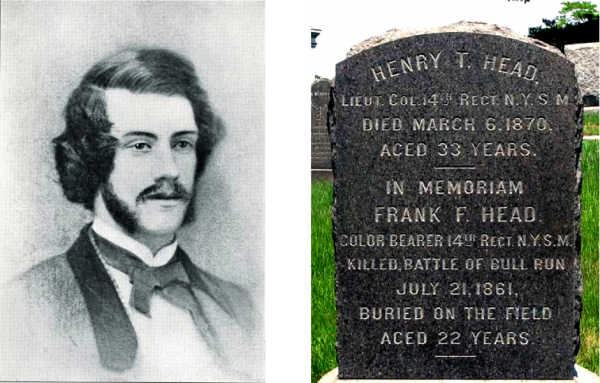
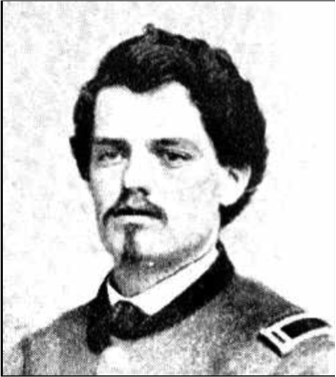
HEAD, HENRY THOMAS (1837-1870). Major, 84th New York (14th Brooklyn) Infantry. After enlisting as a sergeant major at Brooklyn on April 13, 1861, he mustered into the 14th Brooklyn on May 23. He served valiantly at the Battle of First Bull Run, Virginia (his younger brother, Frank Head (see), also fought there with the 14th and was killed in that battle), and was promoted to first lieutenant and adjutant on August 3, 1861, and later to major on May 12, 1863, serving in that capacity at the Battle of Gettysburg, Pennsylvania. As per an article in Military Images Magazine (2022), he suffered a slight head wound from a spent musket ball at Gettysburg. On June 6, 1864, he mustered out at New York City. His regiment elected him unanimously to the rank of lieutenant colonel when there was a vacancy in August 1869. During his military service, he contracted consumption that ultimately caused his death in March 1870. His last residence was at 127 Portland Avenue in Brooklyn. He was survived by his wife, Pamilla, whom he had married in 1868, and a son, Henry.
Members of the 14th assembled in uniform at the City Armory and took part in his funeral. According to a newspaper article about his funeral, Head was eulogized for his meritorious service to his country, his honorable military service, and the great respect he had earned from friends and comrades. The 14th, under the command of Colonel William DeBevoise (see), escorted the body to Green-Wood, accompanied by solemn music. Head was buried with full military honors. His casket, carried by a caisson, was draped with an American flag. Head’s horse from the Civil War, led by a groom, followed the caisson. Many ordinary citizens followed the procession. Section 107, lot 10179.
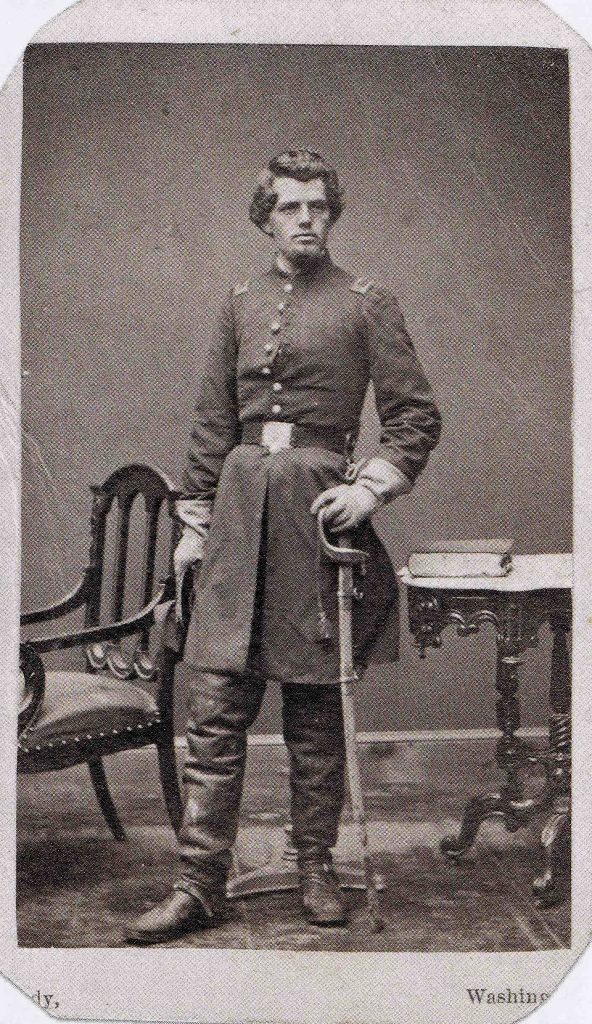
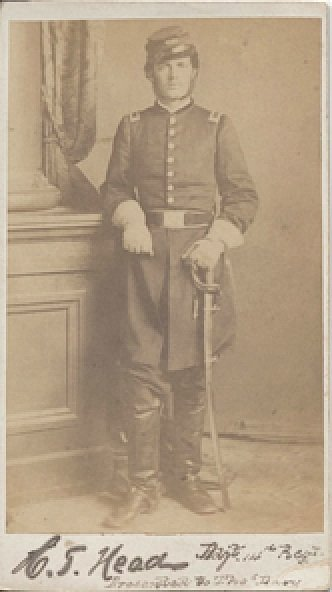
HEALEY, GEORGE WASHINGTON (1846-1881). Private, 20th New York Cavalry, Company L. A native of Lackland, New York, Healey enlisted as a private at Norwich, New York, on September 1, 1864, and mustered into the 20th New York Cavalry on that date. He was discharged on June 14, 1865, at the United States General Hospital in York, Pennsylvania. Healey was listed as a lawyer in Cincinnatus, New York, in 1869. His service is confirmed by the New York Town Clerks’ Registers of Men Who Served in the Civil War, 1861-1865. His last address was in New York City. Section 17, lot 17245, grave 527.
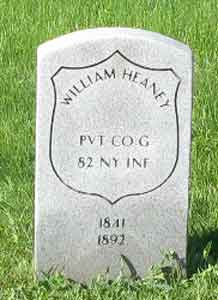
HEANEY, WILLIAM (1841-1892). Private, 82nd New York Infantry, Company G. Of Irish birth, he enlisted and mustered into the 82nd New York on June 1, 1861, at New York City. Further details of his service are not known. In 1881, he advertised the opening of a new Brooklyn store selling fashionable silk and felt hats and French pullovers at “unusually low” prices. As per a news article in the Brooklyn Daily Eagle on January 9, 1888, he served one month as a grand juror for the Court of General Sessions; in another article in the Brooklyn Daily Eagle on February 9, 1884, a stranger, who unlawfully entered Heaney’s house, was taken into custody at the York Street police station. He last lived at 173 Fulton Street, the location of his millinery store, where he died of cirrhosis. Section 205, lot 27376.

HEARSON, FREDERICK L. (1838-1912). Acting third assistant engineer, United States Navy. Born in London, England, he served in the Navy as an acting third assistant engineer beginning on December 24, 1864. An engineer and machinist at the time of enlistment, he was 5′ 6″ tall with blue eyes, dark hair and a fair complexion. Hearson served onboard the USS Fahkee until February 15, 1865; the USS St. Lawrence until March 3, 1865; the USS Martin to May 31, 1865; and the USS Princeton until June 19, 1865. After being granted a leave of absence, he was honorably discharged at Philadelphia, Pennsylvania, on July 17, 1865.
Before moving to Brooklyn in 1874, Hearson lived in Portland, Maine, and Bridgeport, Connecticut. He received an invalid pension from the United States Navy as of 1901 at the rate of $6 per month, certificate 32,776. He cited numerous ailments including kidney trouble, defective eyesight, rupture of the left side, stomach trouble and general debility. Hearson submitted an affidavit which stated that his rupture happened while he was employed at the Brooklyn Navy Yard’s Engineering Department in 1874. He was carrying a flask of mercury from the storehouse to the machine shop when the injury occurred. He wrote that he was perfectly sober and did not know the extent of the injury until he visited a doctor a few days later. At that time, he weighed 136 pounds and had a two inch scar from a gall stone operation. The surgeon indicated that Hearson wore a truss because of the inguinal hernia.
As per his obituary in the Brooklyn Daily Eagle, Hearson was a Freemason; members of his lodge were invited to attend his funeral. He last resided at 217 Madison Street in Brooklyn but he was living at the Brooklyn Home for Aged Men and Aged Couples at 745 Classon Avenue when he died. Shortly after his death, Sarah Hollinshead, vice president of the Brooklyn Home, wrote to the Pension Bureau asking for reimbursement for expenses of $55 for his funeral and burial; although she didn’t know many details about his personal life, she testified that he left no property and had no money. The Pension Bureau responded that if the Brooklyn Home received any subsidy from the state or locality, it was not entitled to reimbursement. Originally buried at the Crematory in Fresh Pond, Long Island, on April 23, 1912, his ashes were interred at Green-Wood on May 12, 1912. Section 179, lot 12291.
HEATH, HENRY S. (1842-1867). First sergeant, 47th Regiment, New York State National Guard, Company G. Heath enlisted as an orderly at Brooklyn on May 27, 1862, mustered into the 47th Regiment that day, was promoted to first sergeant during his service and mustered out after three months on September 1 at Brooklyn. A clerk, his obituaries note that he died after a lingering illness. Records state that the illness was phthisis. His last residence was 101 Joralemon Street in Brooklyn. Section 33, lot 4230.
HEATON, WILLIAM W. (1839-1895). Second assistant engineer, United States Navy. Born in Brooklyn, Heaton studied at Polytechnic Institute, but did not graduate. An article in the Brooklyn Daily Eagle about his death reports that he was one of the first applicants for a scholarship at that institution. He left his studies to offer his service in the Civil War. Through a connection to Secretary of the Navy Simon Cameron, he was appointed as a third assistant engineer in 1861 and saw service on the steam gunboat Katahdin in the West Gulf Blockading Squadron as part of the fleet supporting David Farragut at New Orleans, Louisiana. After capturing the schooner John Gilpin, with its cargo of cotton, the Katahdin proceeded to Vicksburg, Mississippi. The Katahdin was in Baton Rouge, Louisiana, for much of the summer of 1861, doing reconnaissance missions, and provided support to Army troops that landed in Donaldsonville, Louisiana, on September 22, 1861. During the time when the Katahdin patrolled the waters, that ship along with several other Union gunboats, captured 1,500 cattle from Texas and put the animals on transport ships headed for New Orleans. Three thousand Rebel infantrymen supported by nine pieces desperately tried to recapture the cattle. The Katahdin was sent to Galveston, Texas, in January of 1863, where she was ordered to reinforce the blockade. In 1863, Heaton was promoted to second assistant engineer. On April 30, 1864, the Kahtadin was unsuccessful in its efforts to chase the revenue cutter Harriet Lane but was successful on October 31, 1864, in capturing the British schooner Albert Edward which was trying to slip out of the harbor with a cargo of cotton.
Remaining with the Navy after the hostilities ended, Heaton rose to first assistant engineer in 1866. He was in the Asiatic Station on the USS Iroquois from 1867-1870; then served at the Brooklyn Navy Yard, 1871-1872; and Key West, Florida, in 1873. He was promoted to passed assistant engineer in 1874, and returned to the Pacific fleet on the USS Omaha from 1876-1878. Then, he was stationed at the New London Navy Yard in Connecticut from 1878-1881. He returned to the Asiatic Station on the USS Richmond from 1881-1884, then was on special duty at the New York Navy Yard until 1887. After a promotion to chief engineer in 1886, he was sent to the European Station onboard the USS Quinnebaug from 1887-1889. Heaton was stationed at the Quintard Iron-Works in New York from 1890-1893. A year and a half before his death, when there was a problem in Brazilian waters, he was sent there as chief engineer of the fleet aboard the USS Newark. He was also active in the Ulysses S. Grant Post #327 of the G.A.R. and the Union League Club. He last lived at 551 Franklin Avenue in Brooklyn but died at the Naval Hospital on Flushing Avenue where he had been confined for more than six months with heart trouble. Section 54, lot 7432.
HEBBARD, (or HIBBARD), ANDREW J. (1829-1899). Second lieutenant, 39th New York Infantry; sergeant, 132nd New York Infantry, Company H. A New York City native, he was borne on the rolls as “Andrew Hibbard.” After Hebbard enlisted as a private at New York City on September 3, 1862, he mustered into the 132nd New York on October 4. A mason by trade, he was 5′ 8″ tall with blue eyes, brown hair and a dark complexion. He was promoted to sergeant at some point before he rose to second lieutenant on January 2, 1864, and was commissioned into the 39th New York. There are no details of his service in the 39th New York. In 1891, he applied for an invalid pension that was granted, certificate 815,743. He last lived at 182 East 117th Street in Manhattan. Shortly after his death, his wife, Julia Hebbard, who is interred with him, applied for and received a widow’s pension, certificate 522,476. Section 174, lot 21636, grave 13114.
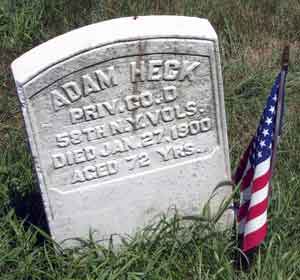
HECK, ADAM (1827-1900). Private, 58th New York Infantry, Company D. Of German origin, Heck became a naturalized citizen on September 19, 1860. During the Civil War, he enlisted and mustered into the 58th on August 14, 1862. As per his muster roll, he was a bootmaker by trade who was 5′ 6″ tall with blue eyes, blond hair and a fair complexion. He mustered out on July 6, 1865, at Nashville, Tennessee.
Heck is listed as a bootmaker in the Brooklyn Directory of 1869. According to the industrial census for his boot & shoe company for 1879-1880, he had invested $100, and had hired four employees who worked a ten-hour day at the rate of $1.33 per day. He paid $416 in total wages for the year, had materials (including mill supplies and fuel) worth $485, and products (including jobbing, repairing and outfitting) worth $1560. The Brooklyn Directory of 1890 states that he was a shoemaker at 535 1/2 Gates Avenue. In 1890, his application for an invalid pension was approved under certificate 627,693. The Veterans Schedule of 1890, which confirms his Civil War service, indicates that he contracted rheumatism during his service. He mustered into the G.A.R. on May 22, 1894. He last lived at 535½ Gates Avenue in Brooklyn. Apoplexy was the cause of his death. Section 127, lot 8259, grave 267.
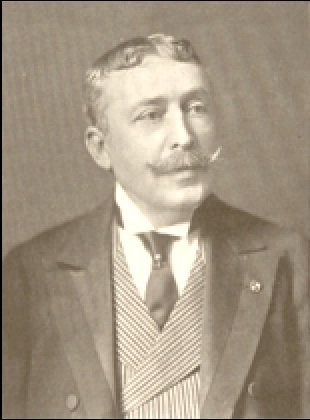
HECKSCHER, JOHN GERARD (or E.) (1838-1908). First lieutenant, 12th Infantry, United States Army; private, 7th Regiment, New York State National Guard, Company K. Born in New York City, Heckscher’s maternal grandfather, John Gerard Coster, was president of the Bank of Manhattan and prominent in New York society. Heckscher grew up on Fifth Avenue at 13th Street in Manhattan, in a brownstone mansion. During the Civil War, he enlisted on May 14, 1861, and was commissioned as a first lieutenant into an unknown company of the 12th Infantry of the United States Army that same day. Heckscher served under General George B. McClellan, and distinguished himself at the Battle of the Wilderness, Virginia, where he was commended for “gallant conduct on the field of battle.” He resigned his commission on August 11, 1862. He then served for 30 days as a private with the 7th Regiment when it was activated in 1863.
A wealthy man, Heckscher associated himself with men who were bringing horse-racing, considered “the sport of kings,” to New York, Messrs. Jerome, Travers, and Belmont. He was a founder and vice-president of the Coney Island Jockey Club and offered attractive cards on days when races occurred there. In addition, he was a founder and secretary of the National Horse Show Association which sponsored annual exhibitions in the off-season.
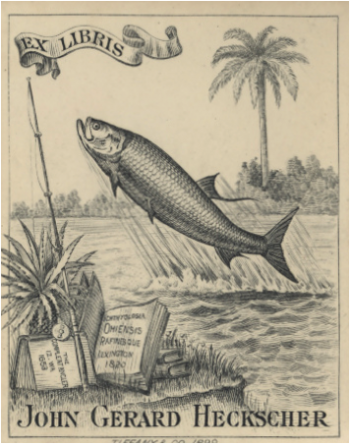
An avid sportsman, Heckscher joined General Philip Sheridan and Buffalo Bill on buffalo hunts in the West and was known for his skill in pigeon-shooting. When Buffalo Bill visited New York City in 1872, Heckscher introduced him to the Union Club and commissioned his tailor to make a suit for his guest. The 186-pound tarpon which he reeled in off the coast of Tampa, Florida, was a decoration in the Tuxedo Club of New York, with which he was associated. A drawing of his catch hung in an inn in Tampa, Florida.
Heckscher also collected books associated with sports. Described as a “clubman” in many sketches of his life, he belonged to the Jockey Club, the New York Yacht Club, the South Side Sportsmen’s Club, the Metropolitan, Racquet and Union Clubs, the Army and Navy Club, and the Military Order of the Loyal Legion of the United States. Prominent in New York society and considered one of the most handsome men of his time, he was also known as a “bon vivant.” One of his daughters married George Brinton McClellan, Jr., the son of the general under whom he had served and a mayor of New York City, in 1889. As per his obituary in The New York Times, which confirms his Civil War service in 7th Regiment, he suffered a stroke in Dresden, Germany, a year before his death which incapacitated him; he then suffered another stroke the day of his death. His last residence was 18 West 88th Street in Manhattan.
In 1909, Heckscher’s collection of fishing books, which were world-renowned, was sold at auction in New York City. The aforementioned collection contained several editions of Isaak Walton’s The Compleat Angler with the original title page, first published in London in 1653. In 2019, a letter signed by Heckscher declining an offer to dine with members of the 7th Regiment’s Engineering Corps, hosted by a prominent banker, Georges Jaques, was offered for sale on eBay. Section 42, lot 10262.
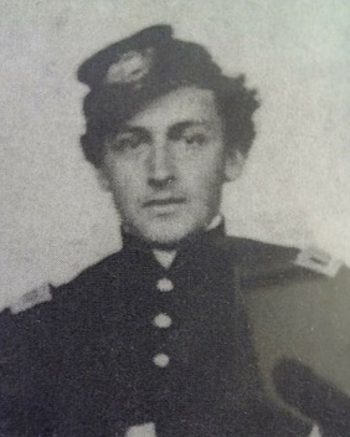

HECKSCHER, MARTIN (1835-1877). Private, 5th Light Artillery, United States Army, Battery L. Born in Germany, Heckscher served with the 5th Light Artillery, United States Army. Further details are unknown. As per his obituary, he belonged to the Court Robin Hood, a fraternal organization; members were invited to attend his funeral. His last residence was 345 West 37th Street in Manhattan. He died of pneumonia. In 1890, his wife applied for and received a widow’s pension, certificate 294,018. His remains were moved to this location in 1879. Section 15, lot 17263, grave 2440.
HEDENKAMP, DIEDRICH (1834-1909). Orderly sergeant, 5th Regiment, New York State Militia, Company A. Hedenkamp was born in Germany. Although no records of his service have been found, his obituary states that he served during the Civil War as an orderly sergeant in Company A of the 5th Regiment in 1861. Hedenkamp held many jobs before he established himself as a saloon-keeper. Internal Revenue Service (IRS) records from 1863 indicate that he was a retail dealer at 32 Oliver Street in Manhattan. In 1874, he was in the grocery business and lived at 273 Broadway in Brooklyn. By 1888, he was in the liquor business with his son, selling beer at 608 Grand Street. As per his obituary, he was a retired saloon-keeper whose business of forty years was at Plymouth and Main Streets. Hedenkamp remained active in military affairs as a member of Abel Smith Post #435 of the G.A.R. and the 5th New York Veterans’ Association. In addition, he belonged to the Oldenburger Verein, a German social club, and the Lutheran Church of St. Paul. He last lived at 199 South 9th Street in Brooklyn, his residence for twenty-five years. Section 157, lot 16124.
HEFFER, HENRY JAMES (1830-1862). Private, 133rd New York Infantry, Company A. Originally interred in lot 3139, grave 281, on November 4, 1862, his remains were removed from Green-Wood on October 10, 1868. Originally from Bristol, England, and a resident of Staten Island, Heffel enlisted as a private at New York City on August 25, 1862, and mustered into the 133rd New York on September 24. A painter, he was 5′ 6″ tall with blue eyes, light eyes and a light complexion. He was fatally shot by accident on October 28, 1862, at Miner’s Hill, Virginia. The adjutant general reported that while Heffer was washing in a brook, a musket discharged and he was accidentally shot in the head by a member of his own regiment. On July 10, 1863, Mary Antoinette Heffer submitted her application for a widow’s pension which was granted under certificate 11,334. In 1866, she asked the court in an affidavit to increase the $8 monthly stipend awarded to her and her minor children. She declared that neither she nor her children aided or abetted the rebellion. In 1901, she reapplied for a pension; at that time, she had remarried and was living in Kansas City, Missouri, and claimed that she had no property.
HEGEMAN, FRANCIS M. (1841-1862). Corporal, 13th Regiment, New York State Militia, Company D. Born on Long Island, Hegeman first served as a private in the 13th New York State Militia for three months in 1861. He re-enlisted as a corporal on May 28, 1862, at Brooklyn, mustered into the 13th that day (then called the National Guard), and mustered out on September 12 at Brooklyn. A day later, he died of typhoid fever. He last lived in Brooklyn. Section 82, lot 2597.

HEGEMAN, JOSEPH (1840-1864). Private, 13th Regiment, New York State National Guard, Company I. Brooklyn-born and a car-man, he enlisted and mustered into the 13th Regiment on May 28, 1862, and mustered out at Brooklyn after serving three months on September 12. An auctioneer, his many ads offered sales of home furniture, farm utensils, oil paintings, Italian statuary, and carriages and sleighs. His office and showroom was on the corner of Willoughby and Pearl Streets in Brooklyn. He last resided at 487 Fulton Street in Brooklyn where he died from consumption. Section 157, lot 15163.
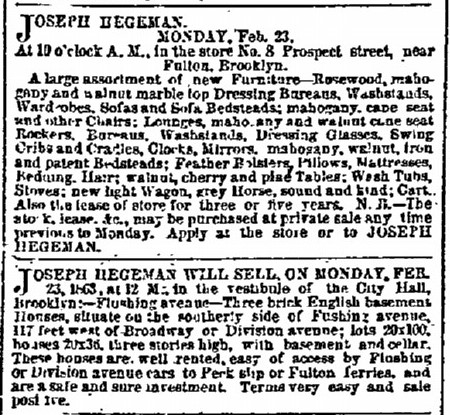
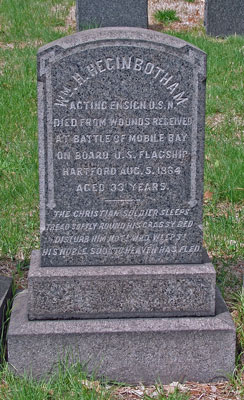
HEGINBOTHAM (or HIGGINBOTHAM, HIGINBOTHAM), WILLIAM H. (1832-1864). Acting ensign, United States Navy; private, 11th New York Infantry, Company E. Born in Maryland, he enlisted at New York City on April 20, 1861, mustered into the 11th New York Infantry on May 7, and deserted on August 1. He re-enlisted as an acting ensign on April 1, 1864, was assigned to Admiral David G. Farragut’s staff, and was killed in battle aboard the USS Hartford in Mobile Bay, Alabama, on August 5, 1864. As per the report of his supervisor, Heginbotham was in the powder division and was mortally wounded by the last shot fired when the Hartford collided with the ram CSS Tennessee. Farragut noted in his report that he had lost a number of “fine fellows” in the victory and that Heginbotham would probably lose a leg; he died hours after the injury. Heginbotham was praised for his coolness, zeal and ability in the performance of his duties. His tombstone is inscribed with the information about his service in the Navy and notes that he died from wounds received at the Battle of Mobile Bay. He was interred at Green-Wood on April 30, 1865. Section 44, lot 11671.
HEIL, FRANK (1833-1880). Musician, 79th New York Infantry. After enlisting as a private on May 13, 1861, he mustered into the 79th New York’s Band, and was discharged on August 18, 1862. According to his pension record, he held the rank of musician and was in the 79th Field and Staff at discharge. In 1869, he applied for and was granted an invalid pension, certificate 98,808. Heil’s death was caused by phthisis (tuberculosis). Louisa Heil, who is interred with him, received a widow’s pension, certificate 146,480. Section 46, lot 23129.
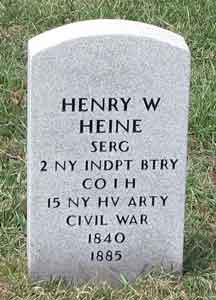
HEINE (or HEIN), HENRY (or HEINRICH) W. (1840-1885). Sergeant, 15th New York Heavy Artillery, Companies I and H; private, 29th New York Infantry, Company H; 2nd New York Independent Battery. Of German origin, Heine immigrated to the United States in 1846. During the Civil War, he enlisted as a private at New York City on May 17, 1861, and mustered into the 29th New York on June 4, where he was borne on the rolls as Heinrich Hein. A tailor by trade, he was 5′ 7″ tall with dark eyes, dark hair and a dark complexion. He was transferred into the 2nd New York Independent Battery on July 21, 1861, from which he was discharged on June 13, 1863. Subsequently, he enlisted as a private at New York City on September 4, 1863, and mustered into Company I of the 15th New York Heavy Artillery. After his promotion to corporal on December 31, 1863, he was promoted to sergeant on January 15, 1864, and received an intra-regimental transfer to Company H a month later on February 15 when he was reduced in rank to private. He was discharged on June 7, 1865, at Camp Parole, Annapolis, Maryland. In 1893, his application for an invalid pension was approved under certificate 903,534. His last residence was 168 Forsyth Street in Manhattan where his death was caused by phthisis. Section 117, lot 10975, grave 1202.
HEINRICH, CASPAR (1828-1870). Private, 66th New York Infantry, Company A. Born in Prueben, Germany, Heinrich immigrated to the United States in 1852, arriving in New York onboard the Splendid. During the Civil war, he enlisted at New York City as a private on September 21, 1861, and mustered into the 66th New York on that date. He deserted from his unit on October 2, 1861, at New York City. His last residence was 184 Hester Street in Manhattan where he died from phthisis. Section 127, lot 17931, grave 493.
HEINRICH, PHILIP (or PHILIPP, PHILLIP) H. (1838-1890). Sergeant, 7th New York Infantry, Company D. Of German birth, Heinrich enlisted at New York City as a private on April 29, 1861, and mustered into Company D of the 7th New York. At some point, he was promoted to corporal of his company. On July 20, 1862, in New York City’s Court of Common Pleas, Heinrich, in a sworn affidavit, pledged his allegiance to the Constitution of the United States. On December 13, 1862, he was wounded in action at the Battle of Fredericksburg, Virginia, and subsequently rose to sergeant of his company on January 1, 1863. He mustered out on May 8, 1863, at New York City.
At the time of his passport application in 1877, Heinrich was a naturalized citizen who was 5′ 10″ tall with blue eyes, broad forehead, black hair flecked with gray, round chin and full face. In 1889, his application for an invalid pension was approved, certificate 846,203. His last residence was 90 Thompson Street in Manhattan. Shortly after his death from hepatitis, Christina Heinrich applied for and received a widow’s pension, certificate 404,251. Mrs. Heinrich died in 1893, leaving her heirs $7,000 in real estate and $8,000 in personal property. Section 117, lot 10975, grave 342.
HEINS (or HINES, HYNES, HEINES), WILLIAM M. (1834-1904). Sergeant, 99th New York Infantry, Company B; private, New York Union Coast Guard, Company E. Of Irish origin, Heins enlisted at New York City as a private, on May 28, 1861, and mustered into the New York Union Coast Guard on June 14. On September 1, 1861, he transferred into Company B of the 99th New York as a private and was promoted to sergeant at some point. As per his muster roll, he was detached as seminary guard in January and February 1862, as provost guard to Hampton Bridge in March 1862, and as provost marshal guard at Fort Hamilton, Virginia, in April 1862. On April 24, 1863, he was wounded in the foot while in action at Suffolk, Virginia, and sent to the United States General Hospital at Fort Monroe, Virginia, on May 4. The muster roll notes that he was detached as a guard at Fort Union in April 1864 and detached on a secret expedition on May 26, 1864. He mustered out on July 2, 1864, at New York City. Heins was living in Williamsburg, Brooklyn, at the time of the 1870 census. On May 6, 1884, he became a member of the Grand Army of the Republic, Mansfield Post #35 in Brooklyn. Heins last lived at 263 West 68th Street in Manhattan. Section 116, lot 10975, grave 195.
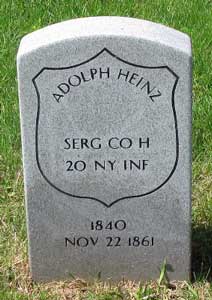
HEINTZ (or HINES), ADOLPH (or ADOLPHUS) (1840-1861). Sergeant, 20th New York Infantry, Company H. Of German birth, he enlisted at New York City on May 3, 1861, and mustered in three days later. He contracted typhoid fever at Fort Monroe, Virginia, and died on November 22, 1861, at General Hospital at Camp Hamilton, Virginia. He was the brother of Christian (see) and John (see). On March 30, 1864, Wilhelmina (Mina) Heintz, his young widow, applied for and received a widow’s pension, certificate 46,789. In her affidavit, she declared that they were married in New York City on July 10, 1861 (four months before his death). She also declared that “she has not in any manner engaged in, or aided or abetted, the rebellion in the United States.” Section 186, lot 18840.
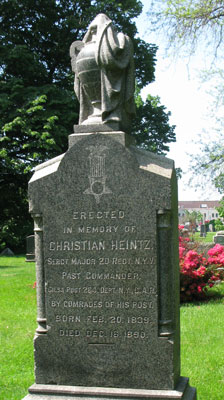
HEINTZ (or HINES), CHRISTIAN (1839-1890). Sergeant major, 20th New York Infantry, Company H. A native of Hesse-Darmstadt, Germany, Heintz enlisted as a private at New York City on May 3, 1861, along with his brothers (see Adolph and John Philip Heintz). He mustered into the 20th New York, a regiment formed by many of German heritage and known as Turner’s Rifles, three days later. He was promoted to sergeant major on July 6, and was discharged for disability on November 28, 1862, at Aquia Creek, Virginia. According to the census of 1880, he was an upholsterer by trade.
As per an article in the New York Herald on September 16, 1887, headlined On The Warpath Again, surviving veterans of the 20th New York, including Heintz and his brother John, were expected to reach Sharpsburg, Maryland, on September 17 to unveil a monument in honor of those in their regiment who died at the Battle of Antietam. The 70-80 veterans were escorted in Sharpsburg and on the battlefield by the Antietam Post of the Grand Army of the Republic. The monument consisted of a simple slab that was fourteen feet high and four feet wide crowned by bronze emblems suggestive of the battle that was fought there and inscribed, “In Memory of 20 Rgt.” Heintz’s funeral was held at the headquarters of the Leopold Von Gilsa (see) Post #264 of the G.A.R., of which he had been a member. He last lived at Madison Avenue and East 59th Street in Manhattan. Phthisis is listed as the cause of his death. Emma Heintz, who is interred with him, applied for a widow’s pension in 1891 that was granted under certificate 324,005. The Leopold Von Gilsa Post erected a headstone in his honor at his gravesite. Section 186, lot 18840.
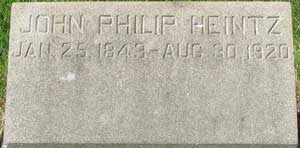
HEINTZ (or HINES), JOHN PHILIP (1843-1920). Private, 20th New York Infantry, Company H. Of German origin, Heintz enlisted as a private at New York City on May 3, 1861, mustered into his company three days later, and mustered out on June 1, 1863, at New York City. The New York City Directory of 1876 indicates that he was an upholsterer by trade.
As per an article in the New York Herald on September 16, 1887, headlined On The Warpath Again, surviving veterans of the 20th New York, about 70-80 in number and including John P. Heintz and his brother, Christian, were expected to reach Sharpsburg, Maryland, on September 17 to unveil a monument in honor of those in their regiment who died at the Battle of Antietam. The simple eight foot slab was inscribed, “In Memory of 20 Rgt.” The veterans were escorted to the unveiling on the 25th anniversary of the Battle of Antietam by the Antietam Post of the G.A.R. He was a member of the Leopold Von Gilsa Post #264 of the G.A.R. and held the position of commander at some point. His application for an invalid pension was granted in 1905, certificate 1,114,235. He last lived in the Bronx and died of apoplexy. He was the brother of Christian (see) and Adolph (see). Elizabeth Heintz applied for and received a widow’s pension in 1921, certificate 896,201. Section 186, lot 18840.
HEITMAN, HENRY (1815-1865). Captain, 5th Regiment, New York State Militia, Company B. Born in Manndorf, Germany, he immigrated to the United States in 1825. When he arrived in New York, the family name was spelled “Heightman.” The roster of the 5th New York State Militia shows that he was a captain in that organization as of 1849. During the Civil War, Heitman enlisted as a captain at New York City on April 19, 1861, was commissioned into the 5th Regiment on May 1, and mustered out at New York City on August 7, 1861. Section 163, lot 15649.
HELLGREN (or HELLGRON), JOHN C. (1830-1901). Private, United States Army. Originally from Sweden, Hellgren immigrated to the United States in 1855. He enlisted in the United States Army and his record from Detroit, Michigan, notes that he was a teacher with gray eyes, brown hair and a fair complexion. He apparently deserted on July 10, 1862. Other details of his service, including the company to which he was assigned, are unknown. On August 20, 1870, he became a naturalized citizen and stated on his official papers that he was a musician. Hellgren is listed as a musician in the New York City Directory of 1878 and the 1880 census. His last residence was 1491 Lexington Avenue, New York City, where he died from apoplexy. Section 136, lot 28307, grave 350.
HELME, (or HOLME), JAMES (1818-1911). Private, 124th New York Infantry, Company K. Helme, who was born in Brighton, England, enlisted as a private on September 3, 1864, at Goshen, New York, and mustered immediately into the 124th New York. A farmer, he was 5′ 5″ tall with hazel eyes, dark hair and a florid complexion. He mustered out with his company on June 3, 1865, at Washington, D.C. In civilian life, he later worked as a gas fitter and as a clerk. Although he applied for an invalid pension, application 631,950, it was never certified. His last residence was 31 Cranberry Street, Brooklyn. After his death attributed to old age in 1911, his children inherited $15,000 in real estate and $2,500 in personal property. Section 143, lot 26346, grave 2.
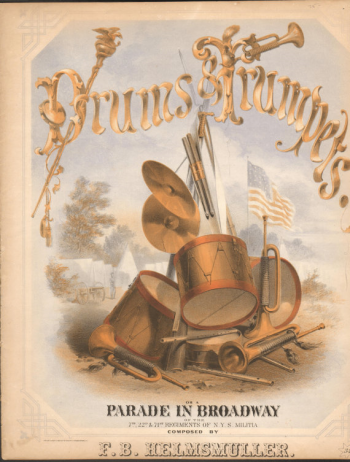
HELMSMULLER, FRIEDRICH (or FREIDERICH) (1820-1865). Private, 22nd Regiment, New York State National Guard, Company H. Originally from Germany, Helmsmuller was a musician of renown whose arrangement of Trab, Trab Galop was performed by the Germania Society in 1859. As per a news story in the Newport Mercury [Newport, Rhode Island] on July 13, 1861, he was a fixture in that community during the high season. The article reports that most of the members of his band were off to war while he was performing at the Ocean House Hotel. The article goes on to say that “Mr. H.” would have liked to have led the band for the 5th New York, Duryea’s Zouaves, but that was not possible; instead, he was leading a talented corps from the 7th New York.
The History of the Twenty-second Regiment of the National Guard, Part 4, indicates that the 22nd Regiment hired Helmsmuller as its band leader in September 1861. Monies were raised for the forty-four piece band by proceeds from concerts and donations by officers and companies. In addition, each company had two enlisted men who were drummers; these men were paid for their services when they paraded. Helmsmuller composed Parade March of the 22nd Regiment-Union Greys which became celebrated, although critics said was modeled after an Austrian march. In addition, he composed President Lincoln’s Grand March (1862), Drums & Trumpets (1862), Fort Federal Hill Quickstep (1862) and other rousing compositions. The band was present at Harper’s Ferry, Virginia, and was taken on the Pennsylvania campaign where its music was featured at dress parades at Camp Cox. Helmsmuller’s soldier record shows that he enlisted on May 28, 1862, at New York City, as a private. On that date, he mustered into the 22nd National Guard from which he mustered out three months later at New York City on September 5. On January 22, 1863, Helmsmuller’s Band from the 22nd Regiment performed at the Brooklyn Academy of Music. After his death, nearly 100 musicians, in civilian attire, followed his hearse, playing a dirge. His last residence was 393 Broome Street in Brooklyn where he died from consumption. Harvey Dodworth (see) later took over the 22nd’s Band. Section 113, lot 17109.
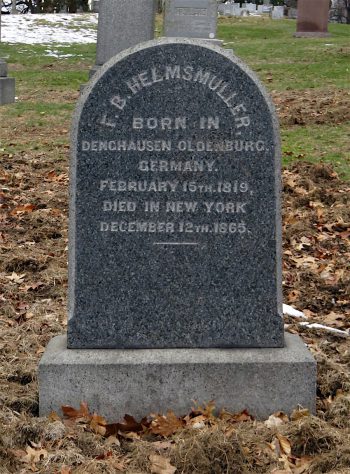
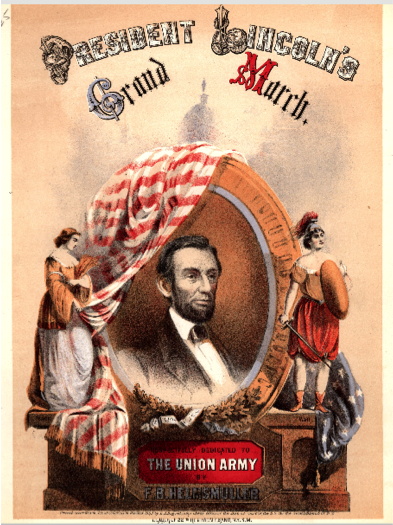
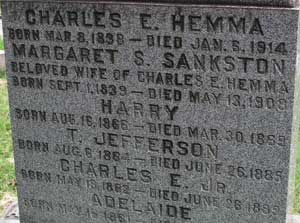
HEMMA, CHARLES EDWIN (1838-1914). Private, 71st Regiment, New York State National Guard, Company C. Hemma’s name appears as a student at the New York City Free Academy 1851-1853. Called to active duty during the Civil War for 30 days, he mustered into the 71st National Guard and served from June 17-July 22, 1863. According to the census of 1880, he was living in Queens, New York, and was employed as a bookkeeper. An article in the Brooklyn Daily Eagle on February 23, 1902, reports that Hemma was part of a committee of veterans who presented a silver loving cup to Colonel Henry P. Martin (see) of the 71st Regiment as a tribute to him after the 71st Armory was destroyed by fire and all of that regiment’s Civil War records were lost. In 1907, he applied for an invalid pension, application 1,361,144, but there is no evidence that it was certified. As per his obituary in the New York Herald, he was a member of Lafayette Post #140 of the G.A.R. and the 71st Veterans’ Association. Members of his G.A. R. Post were invited to attend his funeral in uniform or in civilian attire with badge. He last lived at 30 East 5th Street in Brooklyn but died in Greenwich, Connecticut. Section 45, lot 5271.
HEMMA, THOMAS JEFFERSON (1839-1904). Private, 83rd New York Infantry, Company E; Veteran Reserve Corps, 2nd Battalion, Company 132. Hemma, who was born in New York and employed as a retail dealer at 30 West Broadway in Manhattan, first served with the 12th Regiment when it was activated for three months in 1861. Although not on his soldier record, he gave a report about the 12th Regiment’s trip on the transport ship, the Baltic, which was published in the New York Herald in 1861. Hemma was identified as one of the “returned invalids.” When he returned home to New York City from Annapolis, Maryland, he had narrowly escaped death from sunstroke. Hemma recalled the journey, focusing on the lack of comforts on the ship.
…We had regaled with no more luxurious refreshments than hard sea biscuit, which were liberally supplied, but which were a hard exchange for the numerous comforts of New York. This was to be rather an unlooked for-and early beginning of the hardships of warfare. Our men were mostly stowed away in the steerage, closely huddled together. Others quartered themselves on the hurricane deck, and wrapped in their warm military blankets, endeavored, as best they could, into the sweets of slumber. The men in the steerage whiled away the time in the merriest manner. I was among this jolly crowd, and my efforts to sleep, as a natural consequence, were fruitless….
Hemma remembered the drill in the intense heat the next morning:
The sun was intensely hot, and the men complained bitterly of the long drill. The officers were nevertheless very considerate, and requested any of the men who felt themselves too weak to continue, to leave the ranks and rest for a while in the shade. None of the men showed a desire to avail themselves of the kind offer, but Capt. Boyle, my commander, noticed that I was not well, and told me to leave if I did not feel strong. I replied that I could go through with it, but the drill had scarcely recommenced when I was struck senseless, and when I next awoke I found myself stretched on a bed in the ladies’ drawing room, which had been set apart for an hospital….
Although Hemma was among four members of the 12th who returned to New York, it was conjectured that the Baltic was headed for Annapolis and that the transport ship would ply the waters between the two cities.
He re-enlisted at New York City as a private on October 1, 1861, and mustered into Company E of the 83rd New York the next day. He wrote the following letter to the editor that was published in The New York Times on February 15, 1862, from the U.S. Hospital at Frederick, Maryland.
To the Editor of the New-York Times:
SIR: Will you allow me through the columns of your valuable journal to acknowledge the receipt of two cases containing about 1,000 books for the use of the soldiers at this hospital. These books were presented by the members and friends of the 43rd St. Methodist Episcopal Church, through the Pastor, Rev. HENRY J. FOX.
He saw action at the following battles: Cedar Mountain, Virginia; Second Bull Run, Virginia; Antietam, Maryland; Fredericksburg, Virginia; Chancellorsville, Virginia; and Gettysburg, Pennsylvania. It was at Gettysburg where Hemma was wounded in both legs. He was transferred into the Veteran Reserve Corps on January 24, 1864, a unit composed of men who were partially disabled but judged meritorious and fit for light duty. Hemma was in the Second Battalion of the Veteran Corps, men who suffered more serious injuries including loss of limbs or other grave wounds and were assigned as cooks, nurses, or guards in public buildings. A carte-de-visite, or calling card, of Hemma, which was offered for sale on-line and is pictured below, shows him in the light blue coat and trousers of the Veteran Corps. It is possible that his hand is on the table for balance, perhaps because of his injuries.
Hemma had a variety of jobs after the War including sash maker (maker of window sashes and paneled doors) in 1869; clerk, according to the New York City Directory of 1877, and embalmer as per the New York City Directory of 1889. According to the census of 1900, he was an undertaker. The Veterans Schedule of 1890 confirms his military service, listing his service in the 9th Regiment which was reorganized into the 83rd. He successfully applied for an invalid pension in 1892, certificate 683,864. An article in the Brooklyn Daily Eagle on May 31, 1896, was headlined, How Grant Was Buried. As per that article, Hemma, the assistant embalmer present at Mount McGregor, was given a photograph of President Grant taken on the veranda a few days before Grant’s death in 1885. Hemma accompanied the President’s body from the Mount McGregor house to Albany and then to New York City, a journey in which thousands paid last respects. The funeral costs, borne by the government, at $14,163.73, were the most expensive to that date. The article also states that Hemma had many Civil War relics, the most prized being a small Plaster of Paris mold for the gold plate which was put on Grant’s casket. Hemma also saved pieces of crepe, fringe and rosette, a scrap of purple velvet used to line the casket and a piece of the flag that was draped on the casket at City Hall. Among his Civil War memorabilia were a soldier’s watch ornament made from walnut that was carved and decorated, a silver watch made in London, a piece of skull from South Mountain, and spurs from Winchester and South Mountain. He also attested that he met Barbara Frietchie, through her niece, and owned a flag that had once been on her grave. At the time of his death caused by heart disease, he resided at 30 East 5th Street in Windsor Terrace, Brooklyn. His widow, Mary Hemma, applied for and received a pension in 1904, certificate 577,256. Section 86, lot 31217, grave 144.
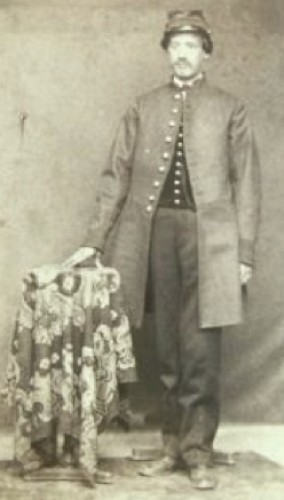
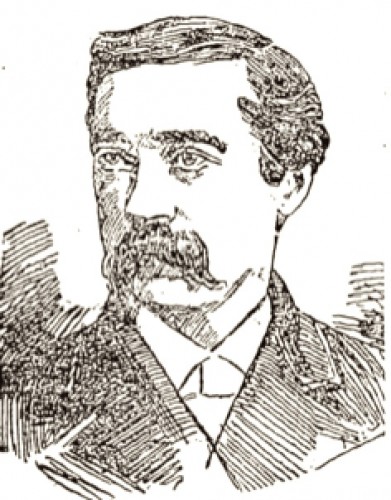
HEMMINGWAY (or HEMINGWAY), CHARLES B. (1840-1916). Sergeant, 6th New York Cavalry, Company A. A Brooklyn native, the 1860 census lists him as a stonecutter. After enlisting as a private at Brooklyn on August 20, 1862, Hemmingway mustered into the 6th New York Cavalry that same day. As per his muster roll, he was 5′ 8″ tall with blue eyes, brown hair and a dark complexion. His muster roll also notes that he was an orderly for General Henry W. Slocum (see) as of April 29, 1863, and was promoted to corporal on June 8, 1863. A per a descendant, he fought at Gettysburgh, where he was bayoneted in one leg; he killed the rebel soldier with his sword. He was wounded at Todd’s Tavern, Virginia, on May 7, 1864, and was listed as absent on the muster roll until October 1864. Hemmingway was promoted to sergeant on January 1, 1865, and mustered out on June 5, 1865, at Cloud’s Mills, Virginia.
The 1870 census indicates that he was living in Brooklyn with his wife and children and was still working as a stonecutter. In 1879, his application for an invalid pension was approved, certificate 174,646. At the time of the 1880 census, Hemmingway lived at 203 22nd Street in Brooklyn with his wife and children and worked as a marble-cutter. The 1900 census reports that he had been married for 34 years, lived at 630 20th Street in Brooklyn and worked as a stonecutter. By 1910, the census notes that he had moved to 112 East 3rd Street in Brooklyn, lived with his wife and other family members. He last lived at 128 East 3rd Street in Brooklyn. His death was attributed to a cerebral hemorrhage. Mary Hemmingway applied for and received a widow’s pension in 1916, certificate 808,360. Section 104, lot 7386.

HEMPHILL, HENRY (1844-1897). Private, 2nd New York Infantry, Company E; 70th New York Infantry, Company A. He enlisted and mustered into the 2nd New York at Troy, New York, on March 17, 1862. On May 11, 1863, he transferred into the 70th. Wounded at Gettysburg, Pennsylvania, on July 2, 1863, he was discharged on March 23, 1864, at Brandy Station, Virginia. Section 134, lot 29725.
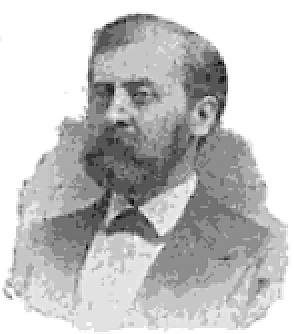
HEMSTREET, WILLIAM (1834-1920). Lieutenant colonel and major by brevet; captain, 18th Missouri Infantry, Companies G and K; private, 57th Illinois Infantry, Company I. Hemstreet, who was born in Oneida County, New York, was a stenographer and lawyer with the Illinois Central Railroad Company in 1861. At the start of the Civil War, he left his civilian position on April 19, 1861, and accepted an appointment as aide-de-camp to General R. K. Swift who occupied and fortified Cairo, Illinois. Hemstreet was a drill officer at Camp Douglas through the winter of 1861-1862. On February 1, 1862, he enlisted as a private and mustered into Company I of the 57th Illinois. He participated in actions at Fort Donelson and Shiloh, Tennessee. Upon his promotion to first lieutenant on April 2, 1862, at Pittsburgh Landing, he was commissioned into Company G of the 18th Missouri. He was promoted to captain on September 17, 1863, effective upon his transfer to Company K, served on the staff of General Joseph Mower as judge advocate and provost marshal and also served as one of General William T. Sherman’s provost marshals on his famous March to the Sea. On March 13, 1865, he was promoted by brevet to major and to lieutenant colonel. He mustered out of service on July 18, 1865.
For 34 years, Hemstreet was the official stenographer for the Brooklyn Court, traveled in Europe and spoke extensively. In 1875, he wrote, The Economical European Tourist-A Journalist Three Months Abroad for $430, a guide that included tips for hotels, travel, sight-seeing with costs and comparisons between America and Europe. In 1881, he successfully applied for a pension, certificate 695,130. In 1892, Hemstreet addressed the reunion of the survivors of the Army of the Tennessee, saluting the officers present at the gathering, who were at the crossing of the Salkehatchie, South Carolina, at Rivers Bridge 27 years prior. He concluded his speech by asking for a committee to erect a suitable monument for General Joseph Mower whose death in 1870 was hastened by exposure at Salkehatchie. Hemstreet was called upon to give a lecture on Sherman’s March to public school children at All Souls’ Church in Williamsburg, Brooklyn, after his commanding officer, General Henry W. Slocum (see) died unexpectedly in 1894.
Interested in transportation, he devised a patent for a rail car-fender that included a lever that prevented the fender from striking the rail or the ground. According to an article on August 10, 2012, in The New York Times, Hemstreet was a history buff who paid a contractor $5 in 1888 to pry a mantel off the wall of the house where Edgar Allan Poe lived on West 84th Street and that was featured in his famous poem, The Raven. Recognizing the significance of the mantel twenty years later, Hemstreet offered to give the piece to an institution that valued its history and would preserve it. He responded to the offer from Columbia University’s President Nicholas Murray Butler who vowed that “It will be appropriately placed and sedulously cared for. A proper inscription would be placed over or near the mantel showing what it is and giving the name of the donor. It would undoubtedly be an object of great interest to thousands of persons, not only students but others as well.” As of May 2012, the mantel is now on view in Butler Hall’s Rare Book Collection after more than a century in a less public location. He last lived at 1332 Bergen Street in Brooklyn. Hemstreet died of phthisis. Section 185, lot 33397, grave 1.
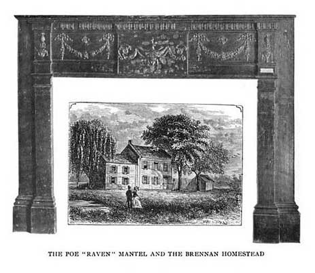
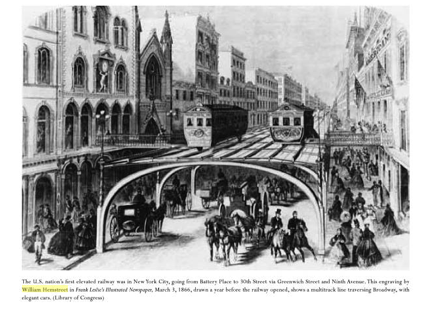
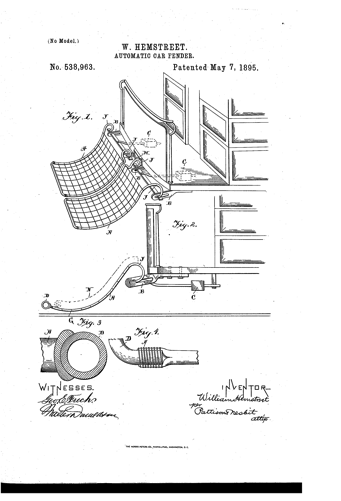
HEMSWORTH, DENTON E. (1840-1881). Private, 71st Regiment, New York Infantry, Company E. Of Irish birth, Hemsworth enlisted as a private and mustered into the 71st Regiment on June 28, 1862. He mustered out after three months on September 2 at New York City. At the time of the 1863 Draft Registration in New York City, he was a sail-maker. Subsequently, he was a fire-fighter with the Metropolitan Hook & Ladder Co. #6, located at 180 Clinton Street. As noted in Reminiscences of the Old Fire Laddies and Volunteer Fire Departments of New York by Frank Kernan, he and another fire fighter were commended for carrying a man, woman and child down a ladder to safety when a fire engulfed their residence. At the time of his death caused by diabetes, he lived at 344 East 120th Street in Manhattan. Anne M. Hemsworth, who is interred with him, received a widow’s pension in 1895, certificate 433,240. According to a report of the New York Fire Department Life Insurance Fund, his wife received $1,000 after his death. Originally interred in lot 5499, his remains were moved to the current location on May 14, 1894. Section 199, lot 28745, grave 3.
HENCKE, JACOB C. (1818-1901). Acting third assistant engineer, United States Navy. Of German origin, Hencke enlisted in the Navy as an acting third assistant engineer on January 29, 1864. A blacksmith by trade, he was 5’9¼” tall with black hair and a pale complexion. He resigned on May 1, 1865. On October 24, 1872, he became a naturalized citizen. He last lived at 266 8th Street in Brooklyn. His death was attributed to senility. Section 202, lot 25537, grave 122.
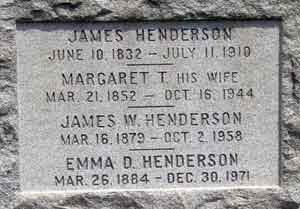
HENDERSON, JAMES (1832-1910). Sergeant, 4th New York Heavy Artillery, Battery G. Born in Stanley, Scotland, he apprenticed as a jeweler in Edinburgh for seven years before immigrating to the United States in 1858. During the Civil War, Henderson enlisted as a private on July 7, 1862, and mustered into the 4th New York Heavy Artillery on October 25. He was promoted to corporal on August 31, 1864, to sergeant on April 1, 1865, and mustered out on June 3, 1865, at Alexandria, Virginia.
In civilian life, he was a prominent jeweler who was the senior partner at Henderson & Winter at 51 Maiden Lane in Manhattan, an enterprise he established in 1873. In addition to designing jewelry, Henderson invented several articles that were used in the jewelry trade. His artistic talent ran in his family; his father was a sculptor to Queen Victoria, and his brother, Joseph Henderson, was a noted marine artist in Scotland. He applied for and was granted an invalid pension in 1898, certificate 969,745. As per his obituaries in the Brooklyn Daily Eagle and the Brooklyn Standard Union, which confirm his Civil War service, he was a member of the Royal Arcanum, a fraternal organization; members of the Royal Arcanum were invited to attend his funeral. According to his obituary in the Brooklyn Standard Union, he was a charter member of the Forest Park Golf Club, an honorary member of the Brooklyn Golf Club, and a Freemason. He was also a member of the G.A.R. Henderson retired from his business in 1909. His last residence was at 395 Jefferson Avenue in Brooklyn. He succumbed to apoplexy. Margaret Henderson, his widow, applied for and received a pension in 1910, certificate 708,188. Section 194, lot 30461.
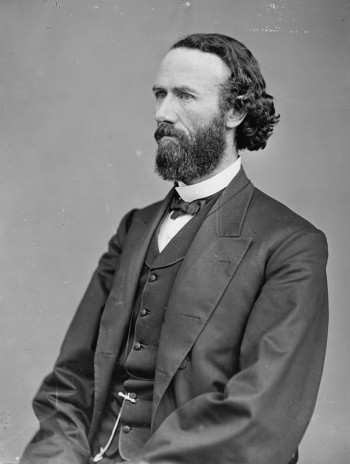
HENDERSON, JOHN BROOKS (1826-1913). Brigadier general and United States Senator from Missouri. Born in Danville, Virginia, he moved with his parents to Missouri in 1832. Orphaned at about age ten, his parents left him a small amount of money earmarked for his education. He first taught school, then became a lawyer and was a member of the Missouri House of Representatives from 1848-1850 and 1856-1858. As per his obituary, he introduced laws that regulated railroads and banking. A state’s rights Democrat who opposed the secession of Missouri, Henderson was one of the most influential forces in keeping that state in the Union. At the outset of the Civil War, he raised a brigade of the Missouri State Militia and was appointed brigadier general commanding federal forces in northeast Missouri. He saw no action, however, because he was appointed to the United States Senate on January 7, 1862, to fill the vacancy caused by the expulsion of Trusten Polk, and was elected to a full term the next year. He was responsible for most of the financial legislation during the War and helped draft the terms for the purchase of Alaska. In 1864, convinced that the Thirteenth Amendment outlawing slavery could only pass if introduced by a border-state senator, he introduced it even though he believed that this would end his political career. The Thirteenth Amendment was signed by President Lincoln on February 1, 1865, but Lincoln was assassinated before it was ratified by the State of Georgia on December 6, 1865.
At one time, a story circulated that Henderson met President Lincoln on the day the President was assassinated and secured a pardon for George S. E. Vaughn, a Missouri resident who was sentenced to death for spying; however, in 2011, David Blanchette, a spokesperson for the Abraham Lincoln Presidential Library and Museum in Springfield, Illinois, noted that there is no record of that pardon, rumored to be Lincoln’s last official act. During President Andrew Johnson’s impeachment trial, Henderson and six other Republicans voted for Johnson’s acquittal. During his tenure in the Senate, he was chairman of the Committee to Audit and Control the Contingent Expense and a member of the Committee on Indian Affairs. He was not a candidate for re-election to the Senate in 1868 and left that legislative body on March 4, 1869. His prediction that his political career would end was right; he ran for governor in 1872 and for senator the next year, and was defeated in both elections. In 1875, he was appointed Special United States Attorney to prosecute a whiskey ring in St. Louis, was president of the Republican National Convention in 1884, and was a regent of the Smithsonian Institution from 1892-1911. From 1891 until his death from septicemia (blood poisoning) he lived in Washington, D.C., where he did writing. His wife, Mary Newton Foote, was from New York City. He is buried in the Foote tomb. Section 34, lot 8379.
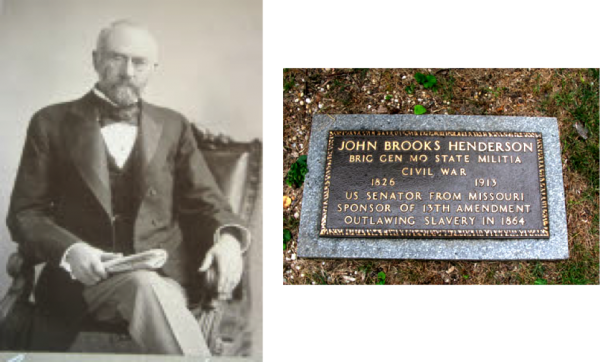
HENDRICKS, THEODORE (1836-1873). Corporal, 84th Regiment, New York State National Guard, Company F; private, 17th Infantry, United States Army, Company H; 12th Regiment, New York State Militia, Company G. Hendricks, a native of New York, first served in the 17th Infantry, United States Army, but the dates of that service are unknown. In 1861, he enlisted in the 12th Regiment for its three month activation. A joiner who constructed the wood hulls of ships, he was 6′ tall with blue eyes and a light complexion. After serving in the 12th Regiment, he was transferred to the 84th New York National Guard in good health. In 1863, he returned to service as a private in the 84th New York National Guard for 30 days. In 1864, he was promoted to corporal and returned to his company in the 84th when it was re-activated for 100 days. His last residence was in Mount Vernon, New York. He was afflicted with heart disease which ultimately caused his death. Section 102, lot 10826.
HENDRICKS, WILLIAM A. (1839-1906). Unknown soldier history. Hendricks was a New York City native. According to his obituary in the Brooklyn Standard Union, he was a veteran of the Civil War. Active in politics, he was a member of the Volunteer Firemen’s Association in Manhattan among many other civic groups. He died of nephritis at the home of his son at 1170 St. John’s Place in Brooklyn. Section 102, lot 10826, grave 8.
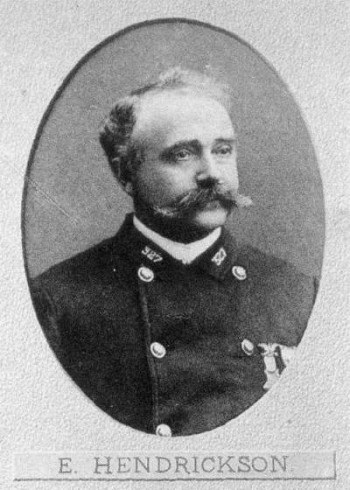
HENDRICKSON, ELEPHALET (or ELIPHALET) (1839-1912). Captain and assistant adjutant-general, United States Volunteers; adjutant, 40th New York Infantry, Companies G, E, and B; sergeant, 87th New York Infantry, Company G; private, 13th Regiment, New York State Militia, Company D. A native of Queens, New York, Hendrickson was in the lumber business at the start of the War. He began his service on April 23, 1861, when he enlisted at Brooklyn to serve for three months. He mustered into the 13th Militia as a private on May 17, 1861, and mustered out at Brooklyn with his company on August 6 after three months. On September 12, 1861, he re-enlisted as a sergeant at Brooklyn, and mustered into the 87th on September 30. He participated in the Battles of Yorktown, Williamsburg and Fair Oaks during the Peninsula Campaign of 1862 in Virginia. Hendrickson was transferred to Company G of the 40th New York, familiarly known as the Mozart Regiment, on September 6, 1862, when the regiments were consolidated. He entered the 40th as a private and rose to corporal and sergeant. Re-enlisting again on February 28, 1864, he rejoined the 40th, and was commissioned second lieutenant on April 16 effective upon his transfer to Company E. He was transferred to Company B on July 7, 1864, promoted to first lieutenant and adjutant on October 8, and mustered out on June 27, 1865, at Washington, D.C. Hendrickson also served in the United States Volunteers, where he rose to the rank of captain and assistant adjutant-general. He participated with the 40th in many battles, including these in Virginia: Fredericksburg, Chancellorsville, Spotsylvania, Cold Harbor, Welden Railroad, Hatcher’s Run and Petersburg; Gettysburg, Pennsylvania, and other engagements leading to the final surrender of Lee at Appomattox.
Hendrickson returned to his former business after the War; then, in 1877, he started a new enterprise manufacturing packing boxes. After the death of President Ulysses S. Grant, he was on duty as part of the Relief Body Guard at Albany, New York, where the former President laid in state. His application for an invalid pension was granted, certificate 1,107,306. His obituary in the Paper Trade Journal, which confirms his Civil War service, noted his affiliations as a member of the Ulysses S. Grant Post #327 of the G.A.R., the 23rd Veteran Association and the Freemasons. He last lived at 57 Berkeley Place in Brooklyn. After his death caused by diabetes in 1912, Lola Hendrickson applied for and received a widow’s pension, certificate 743,789. Mrs. Hendrickson wrote of her husband in memoriam in the Brooklyn Daily Eagle, “No one so stanchly true to faithfulness, kindliness and charity can die and be forgotten.” As per Mrs. Hendrickson’s petition to the Surrogate Court of Kings County, Mr. Hendrickson died without a will but had a personal estate of $250. Section 108, lot 10993.
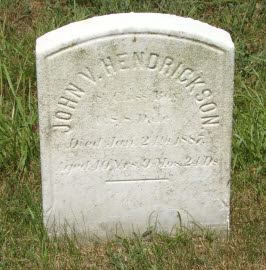
HENDRICKSON, JOHN V. (1849-1887). First class boy, United States Navy. The pension record for his minor children indicates that Hendrickson served as a first class boy on the USS Princeton. He enlisted on February 9, 1862, and was discharged on August 25, 1865. Although his last residence was 95 Hopkins Street in Brooklyn, he was admitted to the Soldiers’ Home in Hampton, Virginia, on November 22, 1886, where he died from tuberculosis.
In 1890, after his wife remarried, his children received a minor’s pension, certificate 7,076. One of his daughters, Emily Jo Hendrickson, was hospitalized for five years and permanently disabled with “hip-joint disease” that impaired her walking. Because of Emily’s disability, her minor pension was extended due to “helplessness”; however, when she married in 1899, the pension was terminated since she no longer was considered “helpless.” Hendrickson’s gravestone, circa 1900, confirms his service in the United States Navy. Section 126, lot 2458, grave 791.
HENEL, FREDERICK (1840-1901). Private, 7th New York Infantry, Company K. Originally from Bavaria, Germany, Henel immigrated to the United States in 1858. He enlisted as a private at New York City on April 23, 1861, and mustered into the 7th New York on that same day. He was wounded in the right arm on July 1, 1862, at Malvern Hill, Virginia, and mustered out on May 8, 1863, at New York City. In 1879, his application for an invalid pension was granted under certificate 198,482. As per the census of 1880, he was living in West Hoboken, New Jersey, where he was employed as a shade painter. He last lived at 291 West Street in West Hoboken, New Jersey. His wife, referred to as Raeka, Fredericka or Henrietta, on various documents, applied for and received a widow’s pension shortly after his death in 1901 from spinal sclerosis, certificate 537,441. Section 206, lot 21706, grave 3.
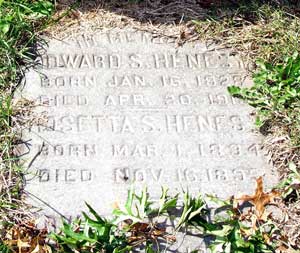
HENESY, EDWARD S. (1828-1915). First sergeant, 8th Regiment, New York State Militia, Company F. Born in England, Henesy enlisted at New York City on April 23, 1861, and mustered into the 8th New York State Militia for a three month term. His regiment saw action in Virginia at Blackburn’s Ford on July 18, 1861, and at Bull Run three days later. Henesy was discharged at New York City when his military commitment expired on August 2.
A member of the Harry Lee Post #21 of the G.A.R., Henesy listed the following men as his intimate comrades: William A. Greene (see), Matthias Johnston, George W. Beeny, and William M. McIntire. In his personal sketch in the G.A.R. book, he wrote that the main event during his service was the re-opening of communication between Baltimore, Maryland, and Washington, D.C., under General Benjamin F. Butler. An active member of the G.A.R., he held the position of officer of the guard and sentry. His death is attributed to “general senile degeneration.” Section 183, lot 19508, grave 2.
HENRICI, HERMANN C. (1834-1896). Private, 8th New York Infantry, Company G. A native of Hanover, Germany, he enlisted at New York City as a private on April 23, 1861, and mustered into the 8th New York Infantry the same day. He served with the regiment until he mustered out on April 23, 1863, at Brooks’ Station, Virginia. The 1880 census indicates that he was employed as an agent for a cloth factory. His last residence was at 328 Clinton Street in Brooklyn. He died on May 14, 1896, and was interred at Green-Wood on October 8, 1903. Section 205, lot 31548, grave 2.
HENRY, CHARLES O. (1841-1867). Captain, 52nd Regiment, New York State National Guard, Company E; private, 71st Regiment, New York State Militia, Company B. Henry first served for three months with the 71st Regiment when it was activated in 1861. He re-enlisted as a captain at Brooklyn on June 19, 1863, was commissioned into the 52nd Regiment that same day, and mustered out with his company after 30 days. Henry last lived at 25 Concord Street in Brooklyn. He died of peritonitis. On May 24, 1888, his remains were moved to the current location. His widow, Frances Henry, who is interred with him, applied for and received a pension in 1890, certificate 394,993. Section 13, lot 12674.

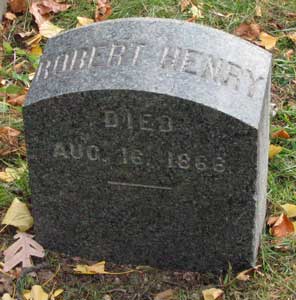
HENRY, ROBERT (1843-1866). Private, 13th Regiment, New York State National Guard, Company F; second lieutenant, 131st New York Infantry, Company H. After Henry enlisted at Brooklyn as a private on May 26, 1862, he mustered into the 13th Regiment from which he was discharged after three months on September 12 at Brooklyn. Henry re-enlisted as a second lieutenant on October 5, 1863, at Brashear City, Louisiana, and was immediately commissioned into Company H of the 131st New York. He was wounded in the chest on October 19, 1864, at the Battle of Cedar Creek, Virginia. Henry’s injury was cited in the Surgeon-General’s Medical and Surgical History of the War of the Rebellion (1861-1865). That report noted that Henry was injured by a conoidal ball which entered the right side of his chest fracturing two ribs and lacerating his right lung. He was discharged for wounds on February 2, 1865.
The pension examiner noted on April 24, 1865, that Henry suffered from tuberculosis as a result of his wound and was confined to bed. On May 8, 1865, his application for an invalid pension was granted, certificate 45,341. He died from the effects of his wounds at his home on Lafayette Avenue in Brooklyn. Dr. W. E. Mulhallen, his Brooklyn physician, submitted this statement on September 21, 1866, “I attended Lieutenant Henry for some twelve months previous to his death which occurred at Brooklyn, August 16th, 1866. He was wounded near the sixth rib anteriorly; the wound healed up and inflammation set in, and it again opened in two places about the fourth rib and continued to discharge until his death. The right lung was affected by this wound, and became entirely useless and wasted away. There can be no possible doubt but that his death was caused by the wound.” On September 26, 1866, his mother, Sarah Henry, who is interred with him, applied for and was awarded a pension under certificate 107,577. Section 157, lot 15970.
HENRY, THOMAS (1840-1888). First lieutenant, 47th New York Infantry, Companies K, D, and G. Of Irish origin, Thomas enlisted as a corporal at New York City on August 24, 1861, and mustered into Company K of the 47th the next month on September 14. As per his muster roll, he was a bartender who was 5′ 3½” tall with brown eyes, dark hair and a dark complexion. He re-enlisted as a sergeant at Hilton Head, South Carolina, on January 1, 1864, was promoted to first sergeant and then became a first lieutenant on March 1, 1865, effective upon his transfer to Company D. He transferred into Company G on May 5, 1865. On October 30, 1865, he mustered out at Raleigh, North Carolina. Henry’s pension record indicates that he also served as an ordinance sergeant (retired officer) in the United States Army. He last lived on Thompson Street in Manhattan and his death was caused by pneumonia. In 1897, his wife applied for and was awarded a widow’s pension under certificate 544,053. Section 162, lot 14222.
HENRY, THOMAS A. (1843-1896). Second lieutenant, 132nd New York Infantry, Company F; sergeant, 95th New York Infantry, Company D. After enlisting as a sergeant at New York City on December 16, 1861, he mustered into the 95th New York the next day, and was discharged for promotion on August 29, 1862. He soon joined the 132nd New York on October 4 of that year as a second lieutenant and was discharged on June 29, 1865. In 1874, his application for an invalid pension was approved, certificate 909,347. His last residence was at 407 West 19th Street in Manhattan. Henry contracted and died from tuberculosis. His wife applied for and received a widow’s pension, certificate 441,354. Section 181, lot 12228, grave 5.
HENSON, JOSEPH (1813-1892). Chaplain, 84th New York (14th Brooklyn) Infantry, Field and Staff. Henson, who was born in England, enlisted on April 5, 1864, and was commissioned as chaplain of the 14th on April 25 upon the resignation of John Inskip (see). He mustered out with his regiment at New York City on June 6, 1864. The 1880 census indicates that he was a minister. An undated local news article “North Shore Jottings” about happenings in Huntington Harbor, Long Island, reported that “Rev. Joseph Henson, of Brooklyn, is recuperating [from scarlet fever] at Oyster Bay.” At the time of his death, he was the reverend of the New-York East Methodist Episcopal Conference. He last resided at 421 Quincy Street in Brooklyn. His death was attributed to “la grippe.” Section 175, lot 25611.
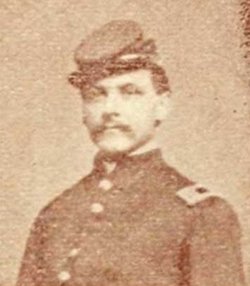
HEPBURN, LEONARD FISHER (1836-1900). Captain, 4th New York Infantry, Companies K and E. After enlisting as a second lieutenant on April 25, 1861, he mustered into Company K of the 4th New York on May 8. He was detached to the Signal Corps on June 12 and promoted to first lieutenant on August 11, 1861. After rapid training, he was stationed with Major Albert J. Myer, Signal Officer of the Army, in a tugboat off Hampton Roads, Virginia, where he could observe the firing upon the enemy’s works at Sewell’s Point and report conditions by flag to battery officers. When better communication was needed for the Army of the Potomac, Hepburn received the following instructional directive from Major Myer in August 1861 at Sugarloaf Mountain, Maryland:
I cannot to (sic) strongly impress upon you the necessity of immediate and thorough instruction of the officers and men of your party. At least five hours in each day must be given to their instruction. This I wish to be almost entirely practiced with small articles held in the hand, and the signals to be made with the greatest rapidity. Practice most thoroughly all officers in repeating signals; that is, there being three officers, the first makes a message which is repeated signal by signal as fast as made by the second, and is read by the third officer, who is not to see the signals made by the first. It is to be answered in like manner.
Twenty-four officers and forty-eight men reported to him for training, one of whom wrote, “…We remained at Darnestown [Maryland] a short time engaged in acquiring a knowledge of our new duties, memorizing the signal code and practicing with ‘wands,’ as certain pine sticks were designated…” Hepburn was promoted to captain on June 30, 1862. During his service, he was transferred from Company K to Company E and then, on June 30, 1862, back to Company K. After his duty in Darnestown, he was sent to Newport News, Virginia, and then stationed in the Upper Potomac. He was detached to the Signal Corps on June 12 and promoted to first lieutenant on August 11, 1861. His photograph, attributed to Matthew Brady, appears in The Photographic History of the Civil War edited by Francis Trevelyan Miller (1912). His brother-in-law, Charles Webster Rodman (see), also served in the 4th New York. He last lived at 458 West 23rd Street in Manhattan, succumbing to cirrhosis of the liver. Section 47, lot 5562, grave 13.
HERBERT, GEORGE R. (1841-1899). Second lieutenant, 159th New York Infantry, Company H. Herbert was born in Queens, New York. After enlisting as a second lieutenant on September 1, 1861, at Brooklyn, he was commissioned into Company H of the 159th New York on October 31. He was detached to the Signal Corps as of November 13, 1862, and assigned to the Department of the Gulf. On October 21, 1863, he was taken as a prisoner of war at Carrion Crow Bayou, Louisiana, and paroled on an unknown date. As per his muster roll, Herbert was discharged on May 7, 1865, upon his resignation; he was officially discharged with his company on October 12, 1865. The 1865 New York State census lists him as a soldier living with his brother and other siblings in Brooklyn. In 1890, his application for an invalid pension was approved, certificate 795,147. The 1892 New York State census reports that he was living in Brooklyn and employed as a city weigher. He last lived at 1339 Bedford Avenue in Brooklyn. His death was attributed to a hemorrhage. Mary Herbert applied for and received a widow’s pension in 1908, certificate 675,523. Section 195, lot 30058, graves 1 and 2.

HERBERT, WILLIAM LOGAN (1827-1863). First lieutenant, 73rd New York Infantry, Company F. Born in Ireland, Herbert enlisted on May 29, 1863, as a first lieutenant, and was immediately commissioned into the 73rd New York. He was killed in action at Gettysburg, Pennsylvania, on July 2, 1863. As per his obituary, he was a Freemason. In 1874, a minor’s pension was awarded under certificate 175,420. Section 127, lot 8259, grave 273.
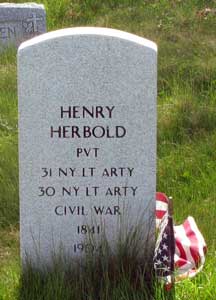
HERBOLD, HENRY (1841-1904). Private, 31st New York Light Artillery; 30th New York Light Artillery. Born in Germany, Herbold immigrated to New York City were he became a naturalized citizen on October 14, 1859. During the Civil War, he enlisted as a private at New York City on November 15, 1861, and mustered into the 31st New York Light Artillery the same day. As per his muster roll, he was a cook who was 5′ 11″ tall with blond hair, brown eyes and a healthy complexion. After he re-enlisted on February 29, 1864, he was transferred into the 30th New York Light Artillery on October 25, 1864, and mustered out on June 23, 1865, at New York City. His pension record notes that he also served in New York’s 1st Battalion, Light Artillery, Company C. His records also note that he was wounded three times during his service and suffered from rheumatism.
On June 18, 1877, Herbold mustered into the Mansfield Post #35 of the G.A.R. at which time he was a saloon keeper. The 1880 census indicates that he was a liquor dealer. He relocated to New Jersey at some point after the Civil War. According to the Hudson County New Jersey Veterans Census in 1890, he was then living there. In 1891, his application for an invalid pension was granted, certificate 875,171. His last residence was at 1167 New York Avenue in Brooklyn. His death was caused by apoplexy. Catharine Herbold applied for and received a widow’s pension in 1906, certificate 651,945. Section 128, lot 31394, grave 53.

HERDER, PHILLIP QUEREAU (1844-1875). Private, 71st Regiment, New York State National Guard, Company C. Herder, who was born in New York State, wrote this letter from New York City on July 22, 1861, when he was only seventeen years old, describing the first major battle of the Civil War, Bull Run, ostensibly based on newspaper reports, and his desire to serve:
Dear Arthur,
…Our troops after a bloody battle captured the batteries at bulls run, but Gen Beauregard rallied his forces and repulsed and drove us to Washington with the loss of 2500 to 3000 men, captured all our batteries and out of the one thousand fire Zouaves but 200 were left. It was a terrific battle and large loss of life but there will be enough to take their places. Anytime that I am called I am ready to go with a willing heart….
Herder enlisted as a private in 1863 and served with the 71st Regiment when it was activated that year for 30 days. When he applied for a passport in January 1865, he was 5′ 9″ tall with blue eyes, brown hair, light complexion, Roman nose, receding forehead, and thin face. At the time of the 1870 census, he was living in North Egremont, Massachusetts. His funeral took place at the residence of his father at 51 West 130th Street in Manhattan. Section 85, lot 3982.

HERKEY (or HAKEY), WILLIAM (1843-1905). Private, 159th New York Infantry, Company K; landsman, United States Navy. A Brooklynite by birth, Herkey enlisted there as a private at Brooklyn on August 30, 1862, mustered into the 159th New York on November 1, and deserted that same day at Park Barracks, New York. On August 8, 1864, he enlisted as a landsman in the United States Navy and was assigned to the USS Fahkee. At the time of the census of 1880, he was a watchman. He last lived at 925 60th Street in Brooklyn. Section 136, lot 28070, grave 262.
HERKNER, HENRY FRANCIS (1837-1903). Artificer, 13th Regiment, New York State Militia, Engineers. A native of New York City, Herkner applied for a passport in 1852. At that time, he was 5′ 3½” tall with hazel eyes, brown hair, fair complexion, high forehead, stout nose, round chin and full face. During the Civil War, he served in his regiment as an artificer for three months in 1861.
In 1870, he obtained a patent for a device called “Firemen’s Buckled-Sleeve Coat.” The invention was devised to keep firemen’s coats waterproof by preventing water from dripping in, a situation that often caused scalding and other infirmities. The invention would also help seamen, miners and cartmen. A merchant, he mustered into the Lafayette Post #140 of the G.A.R. on December 24, 1884. In 1887, he received a patent for a new knit fabric for use in hoses and other similar devices where a smooth and elastic material is needed to prevent the rubber from hardening and cracking. This knit lining would also help firefighters. As per his obituary, he was a noble in his Masonic temple; members were invited to attend his funeral. In addition, he had been a commander in the Knights Templar where he was remembered as a brave-hearted, kind friend. He last resided at 388 Halsey Street in Brooklyn. After his death from apoplexy in 1903, his widow applied for and received a pension, certificate 576,501. Section 74, lot 1814, graves 7 and 8.
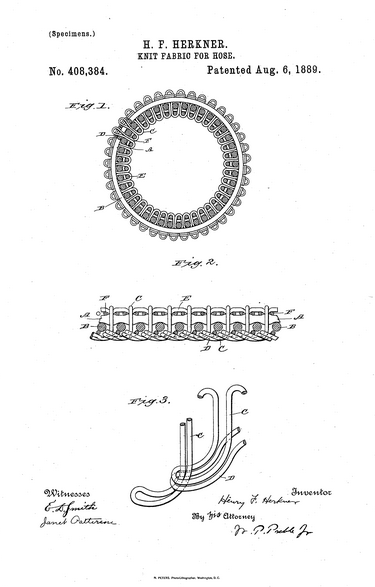
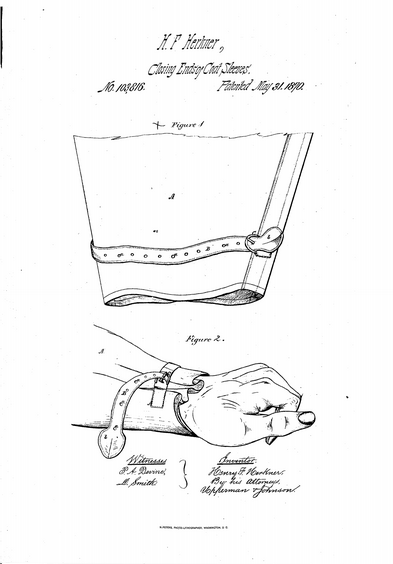
HERMAN, HENRY (1837-1896). Corporal, 25th New York Infantry, Company C. Born in Germany, he enlisted at New York City as a corporal on May 11, 1861, and mustered in on June 13. He was wounded at Gaines’ Mill, Virginia, on June 27, 1862, and sent to the General Hospital in Washington, D.C, where he was listed as a deserter on October 2, 1862. He was demoted to private on an unspecified date. At the time of his death, caused by typhoid fever, he was living at 120 East 15th Street, New York City. Section 74, lot 22987.
HERMANCE, ARTHUR (1828-1874). Second lieutenant, 8th Regiment, New York State National Guard, Company B. After Hermance enlisted at New York City as a second lieutenant on May 29, 1862, he was immediately commissioned into the 8th Regiment and was discharged three months later at New York City on September 10. On June 17, 1863, he re-enlisted as a second lieutenant, returned to the same regiment and company, and mustered out at New York City on July 23. As per his obituary, he was a Freemason. His last residence was 178 Amity Street, Brooklyn. His death was attributed to angina pectoris. In 1892, Elizabeth Hermance, whose ashes are in the same lot, applied for and was granted a widow’s pension, certificate 384,222. Section 28, lot 9956.
HERMANCE, CHARLES (1842-1919). Second lieutenant, 158th New York Infantry; private, 84th New York (14th Brooklyn) Infantry, Company G. A native of Syracuse, New York (although his obituary says Brooklyn), he was the subject of an article in the Brooklyn Daily Eagle on July 15, 1859, when he was married under “singular circumstances.” Hermance, an eighteen-year-old from a very respectable family, had been arrested for “bastardy” and was “required” to marry his father’s servant, Mary Carberry, a seventeen-year-old with a baby “the image of its sire.” The article stated, “Of course the young man was the paternal progenitor of the child and the Superintendent of the Poor, deemed it necessary for the interest of the County that he be made to provide for its support.” Mary, who was questioned in a very trying manner, maintained “a modest and dignified bearing” but refused to answer probing questions in spite of entreaties and was jailed for contempt of court. After being jailed with her baby, who was only two weeks old, and remaining resolute in her refusal to speak, she was released after two weeks when Hermance agreed to marry her. The article concluded, “She appeared to think a great deal of her husband. And he appeared very kindly disposed towards her.”
During the Civil War, Hermance enlisted at Brooklyn as a private on April 25, 1861, and mustered into Company G of the 14th Brooklyn, also known as the Red Legged Devils, on May 23. A sign painter, he was 5′ 5″ tall with blue eyes, brown hair and a fair complexion. Discharged for promotion at Washington, D.C., on September 22, 1862, he was commissioned that day as a second lieutenant in the 158th New York. He was discharged on January 13, 1863, at New Berne, North Carolina. According to the census of 1880, he was a sign painter. Subsequently, he was a clerk in the Ordnance Department at the Brooklyn Navy Yard, a position he held for more than twenty-five years. In 1904, he applied for and was granted an invalid pension, certificate 1,096,368. As per his obituary, which confirmed his Civil War service, he was a member of the Rankin Post #10 of the G.A.R. and was active in the Fourteenth Veterans” Association; both organizations held memorial rites for him. In addition, he was active in Republican Party politics in the Eighth Assemble District for more than fifty years. At the time of his death from cancer, he was a resident of 326 Union Street in Brooklyn. Section 71, lot 2256.
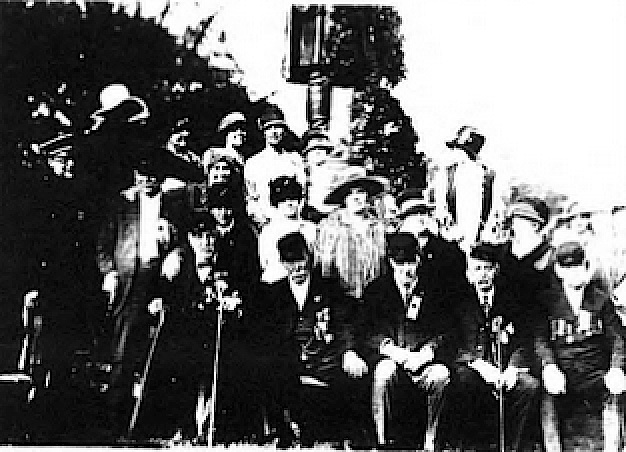

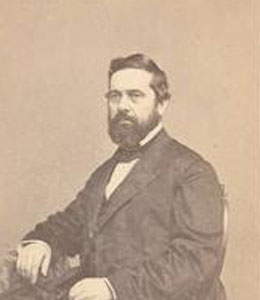
HERRICK, ANSON (1812-1868). Congressman. Born and educated in Lewiston, Maine, his father, Ebenezer Herrick, was a Maine Congressman from 1821 through 1827. Herrick became an apprentice to a printer at fifteen, established the Citizen at Wiscasset, Maine in 1833, then moved to New York City in 1836. Two years later, he became publisher of the New York Atlas, a weekly journal. Active in Democratic Party politics, he was alderman of the 19th Ward from 1853-1857. In 1854, he joined members of the Tammany Society on Independence Day and was the reader of the Declaration of Independence for the 78th anniversary celebration. Herrick was appointed naval storekeeper of New York by President James Buchanan in 1857, serving through 1861. While he was the storekeeper, the Brooklyn Daily Eagle reported that his office was broken into and five silver watches were stolen. The serial numbers of the watches were listed in that news story.
In 1862, Herrick was elected Congressman. He was one of the few Democrats who voted for the 13th Amendment which abolished slavery in the United States. Although Herrick planned to vote for the amendment, he made a deal that in return for his vote, President Abraham Lincoln would appoint his brother federal tax assessor. President Lincoln kept his promise but after his assassination, the recommendation was neither confirmed by the Senate nor supported by President Andrew Johnson. Herrick lost his bid for re-election in a redrawn district in 1864. After his election defeat, he returned to the New York Atlas and with that paper supported President Andrew Johnson’s efforts to fashion a new conservative party after the War. According to an office-holder’s journal in the Black Republican (August 1865), Herrick (Hayrick) spoke and joined a party where “the bottle circulated freely, toasts were drank, and loyal songs were sung.” He was the editor and proprietor of the New York Atlas at the time of his death. Section 174, lot 18333.
HERRICK, MARCUS A. (1839-1871). First lieutenant, 134th New York Infantry, Company H. A New Yorker by birth, Herrick enlisted as a second lieutenant at Schoharie, New York, on August 18, 1862, the same day that he was commissioned into Company H of the 134th New York. He rose to first lieutenant on February 5, 1863, and was discharged on February 21; his soldier record notes that his resignation was accepted on February 23. A member of the New York Stock Exchange, his memory was honored when a resolution was passed to attend his funeral and call no stocks the morning of his solemnities. His colleagues said of him, “That in the death of Mr. Herrick this Board has lost one of its most faithful, active and valued members, one who combined in a rare degree faithfulness towards his principles in the execution of the responsible trusts confided to him and honor towards his fellow members with whom he dealt….” His obituary confirmed his Civil War service. His last residence was 743 Fifth Avenue in Manhattan. Section 70, lot 7770.
HERRING, WILLIAM J. (1839-1902). Captain, United States Navy. Herring served in the Navy during the Civil War beginning as an acting ensign on July 1, 1864, and receiving a promotion to captain before he was honorably discharged on November 15, 1868. He was subsequently a member of the Ulysses S. Grant Post #327 of the G.A.R. He later transferred to the Revenue Cutter Service from which he retired as a captain. Herring was at the helm of the U.S.R.C. Corwin during the Spanish American War. His obituary in the Brooklyn Daily Eagle notes that he was buried with full naval honors. An American flag and the sword and hat that he used in battle adorned his casket, and a squad of marines fired a volley saluting him. He died of a hemorrhage in Baltimore, Maryland, but last lived at 381 Degraw Street in Brooklyn. Section 51, lot 12748, grave 6.
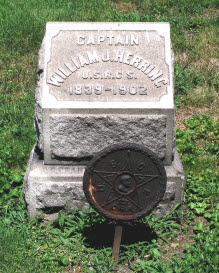
HERZER (or HERZOG), CHARLES (1836-1889). Adjutant, 15th New York Heavy Artillery, Company B. A native of Germany, Herzer used the name “Charles Herzog” when he enlisted at New York City as a first lieutenant on October 8, 1863, and was commissioned into Company B of the 15th New York Heavy Artillery on that date. As per his muster roll, he was a clerk who was 5′ 4″ tall with grey eyes, brown hair and a fair complexion. After he was promoted to first lieutenant and adjutant on December 14, 1863, he was promoted to adjutant a day later, and was discharged for disability on July 28, 1864. He also served in Company A of the 8th New York Infantry but there are no further details related to that enrollment. The 1880 census indicates that was employed as a machinist. His last residence was 94 Greenwich Street in Manhattan. In 1891, his wife applied for and was granted a widow’s pension, certificate 457,026. Section H, lot 17365.

HESKETH, EDWARD (1838-1887). Corporal, 15th New York Light Artillery; 32nd Light Artillery; private, 4th New York Light Artillery. Born in New York City, Hesketh enlisted there as a private on September 9, 1862, and mustered into the 4th Light Artillery the next day. He was transferred into the 15th Light Artillery on December 12, 1863, received a promotion to corporal on November 14, 1864, and was transferred into the 32nd Light Artillery on February 4, 1865, remaining with that unit until he mustered out on July 12, 1865, at New York City. His last residence was at 182 East 111th Street in Manhattan. His death was caused by phthisis. In 1890, his widow, Ann Hesketh, applied for a pension, application 482,511, but there is no certification number. Section 83, lot 2658.

HESS, GEORGE ADAM (or A. GEORGE or ADAM) (1845-1903). Corporal, 67th New York Infantry, Company F. A New York City native, he enlisted as a private, using the name Adam Hess, at South Brother Island, a small island in New York City’s East River, on May 30, 1861, and mustered into Company F of the 67th New York on June 20. Hess was promoted to corporal on October 30, reduced to ranks on December 17, 1862, and then promoted to corporal on or about February 15, 1863. He mustered out on July 4, 1864, at Brooklyn.
As per the census of 1880, which listed him as A. George Hess, he was married, living in New York City, and employed as a police detective in New York City’s 10th Precinct. When he mustered into the Adam Goss Post#330 of the G.A.R., he used the name George Adam Hess. At that time, he was a policeman who lived at 120 Clinton Street in Brooklyn. In 1892, he applied for and received an invalid pension, which indicated that Adam Hess was his alias, certificate 969,178. He last lived at 75 Hooper Street in Brooklyn. He succumbed to pneumonia. Annie Hess applied for and received a widow’s pension in an unstated year, certificate 588,323. Section 186, lot 35873, grave 1.
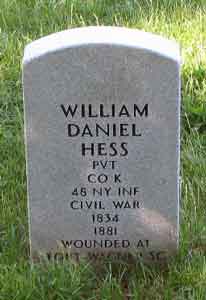
HESS, WILLIAM DANIEL (1834-1881). Private, 48th New York Infantry, Company K. Born in Prussia, Hess enlisted at Galeville, New York, on August 9, 1861, and mustered into the 48th seven days later. On July 18, 1863, he was wounded at Fort Wagner, South Carolina. He re-enlisted on December 22, 1863, and mustered out on September 1, 1865, at Fort Wagner, South Carolina. His last address was 28 Wycoff Street in Brooklyn. His death was attributed to “cardiac hypertrophy.” Section 2, lot 5499, grave 1274.
HEULER, LOUIS (1838-1864). Unknown soldier history. Born in France, Heuler served in the Civil War and died of typhus fever at Fortress Monroe, Virginia, on July 31, 1864. No other details of his military duty are known. Section 127, lot 8259, grave 112.
HEWES, WILLIAM S. (1843-1899). Sergeant, 95th Pennsylvania Infantry, Company K; private , 2nd Ohio Infantry, Company D. Born in Philadelphia, Pennsylvania, he enlisted as a private on April 17, 1861, mustered into the 2nd Ohio two weeks later on April 29, and mustered out on August 9, 1861. He re-enlisted as a sergeant at Philadelphia on October 12, 1861, mustered into the 95th Pennsylvania, and mustered out on November 2, 1864.
As per his obituary from a Philadelphia newspaper, which confirms his Civil War service, Hewes was an accomplished billiards player whose father managed one of the first billiard rooms in Philadelphia. After the War, Hewes entered the billiards business as a room keeper in Philadelphia, then relocated to New York City in about 1884 to enter the hotel business. He retained his love of billiards throughout his life, preferring the traditional one pool table in a room and a charge of no less than 50 or 60 cents an hour for the game. In 1891, he applied for and was granted an invalid pension, certificate 934,476. He last lived at 223 East 57th Street in Manhattan. He succumbed to heart disease. Section 170, lot 13608.
HEWETT (or HEWITT), JAMES D. (1833-1917). Assistant surgeon, 66th New York Infantry; 107th New York Infantry; 119th New York Infantry. Born in Massachusetts, Hewett enlisted at New York City as an assistant surgeon on October 29, 1861, was commissioned into the Field and Staff of the 66th New York on November 4, and was discharged on February 26, 1862. Returning to service, he re-enlisted on August 8 of that year at Elmira, New York, and was commissioned into the 107th as an assistant surgeon that day. He was dismissed on May 1, 1863, and subsequently served in the Field and Staff of the 119th. His last residence was on West 94th Street in Manhattan. Hewett’s death was due to intestinal obstruction. Section 68, lot 1312.
HEWETT, LOWELL E. (1839-1888). Private, 51st Massachusetts Infantry, Company K. Hewlett, a scythe maker by trade and a resident of Blackstone, Massachusetts, enlisted as a private on September 16, 1862. He mustered into the 51st Massachusetts on September 25 and mustered out on July 27, 1863, at Worchester, Massachusetts. As per the censuses of 1865 and 1870, he was living in Worchester, Massachusetts. He was residing in Brooklyn in 1886 and listed in the Brooklyn Directory that year in the watchcase business. The Veterans Census of 1890 confirms his military service in the Civil War. In 1891, his application for an invalid pension was approved under certificate 349,984. He last lived at 46 Prospect Avenue in Brooklyn. “Phthisis pulmonalis asthenia” is listed as the cause of his death. Martha Hewett, who is interred with him, applied for and received a widow’s pension in 1891, certificate 349,984. Section 203, lot 26093.
HEWINS, MILTON K. (1836-1880). Private, 71st Regiment, New York State Militia, Company C. A Brooklynite by birth, Hewins enlisted there as a private in 1861, mustered into Company C of the 71st Regiment, and mustered out at the expiration of his three month enlistment. He last lived with his brother-in-law at 216 West 123rd Street in Manhattan. Hewins died from consumption (tuberculosis). Section 73, lot 5041.
HEWITT, ABRAM STEVENS (1822-1903). Civic leader, iron manufacturer, and mayor of New York City. Born on a farm near Haverstraw, New York, he was raised in New York City. He graduated first in the class of 1842 at Columbia College, then taught mathematics there. In 1844, he visited Europe with classmate Edward Cooper, whose partner he was to become, and whose sister he would marry. He studied law and was admitted to the bar. However, poor eyesight cut short his legal career, and he joined Edward Cooper in the iron business. That business prospered, and the firm of Cooper and Hewitt became one of the largest iron manufacturers in the world. In 1862 he went to England to learn the process of producing gun barrel iron, which he then used to produce material for the Union during the Civil War. He also introduced open hearth steel manufacture to this country. Hewitt was known for his enlightened relationship with his workers; during depressions he continued to operate his works at capacity, refusing to engage in the common practice of laying workers off. He headed Cooper Union. He was elected to Congress in 1874 and served there until 1879, then again 1881-1886.
In 1886, Hewitt was elected mayor of New York City, defeating radical tax reformer Henry George and future President Theodore Roosevelt by emphasizing the common interests shared by workers and employers and campaigning against Karl Marx’s theories. He was mayor from 1887 until 1888. His most lasting contribution to New York was his rapid transit plan, which joined public financing with private ownership and management. He also served as chairman of the Democratic National Committee in 1876, was a leader of the Committee of Seventy which brought down the Tweed Ring, gave the oration at the opening of the Brooklyn Bridge, was president of the American Institute of Mining Engineers, was a member of the Palisades Interstate Park Commission, and was a trustee of Columbia University. However, according to David McCullough in The Great Bridge, “Few politicians of the day enjoyed a more impeccable reputation, a reputation that was undeserved according to private notes kept by the Chief Engineer, Washington Roebling.” Section 97, lot 3932.
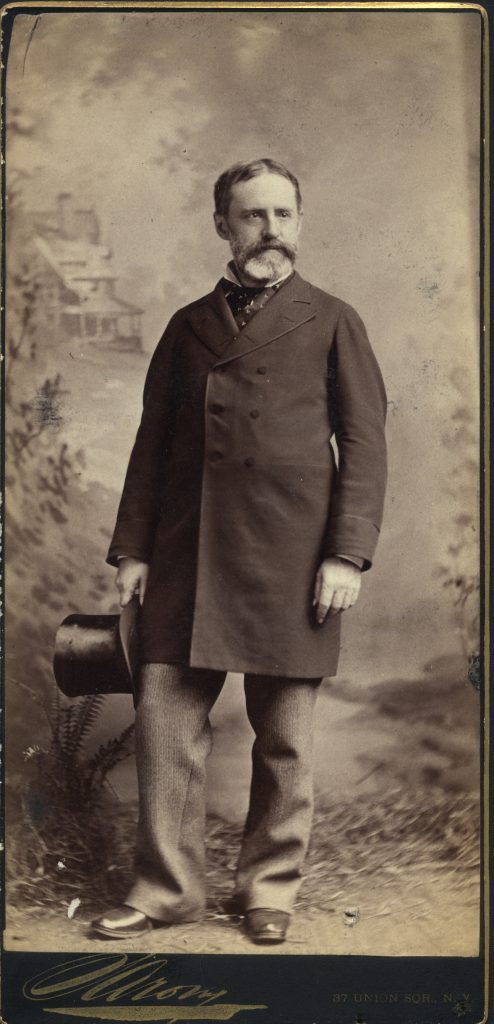
HEWLETT, ALGERNON C. (1829-1905). Private, 7th Regiment, New York State Militia, Company A. Hewlett, a native of New York City, enlisted as a private in 1861 and served with the 7th Regiment when it was activated for 30 days that year. In 1863, when the 7th was part of the New York State National Guard, Hewlett returned to the 7th and served for 30 days. The 1868 New York City Directory indicates that he was in the mirror business; the 1870 New York City Directory notes that he was in the frame business and the 1872 New York City Directory lists him in the glass business. The 1880 census identifies Hewlett as a picture frame manufacturer. He was a member of the Alexander Hamilton Post #182 of the G.A.R.; as per his obituary in the New York Herald, members of the post were invited to attend his funeral. His last address was 10 East 127th Street in Manhattan. Section 173, lot 19426, grave 12.
HEYBOURN (or HEYBOURNE, HAYBOURN), JOHN (1822-1896). Captain, 12th Regiment, New York State National Guard, Company H. A native of Ireland, he enlisted at New York City on May 30, 1862, and was commissioned into the 12th Regiment on June 2. The 12th participated in Virginia at the Battles of Arlington Heights, Martinsburg and Bunker Hill. He was captured at Harpers Ferry, Virginia, on September 15, 1862, part of the largest surrender of troops during the Civil War, by Confederate forces under the command of Lieutenant General Stonewall Jackson. Heybourn was soon released and mustered out at New York City on October 8, 1862. The 1870 and 1880 censuses identify him as a shoe machinist; an article about his daughter’s wedding in 1882 notes that he was a prominent manufacturer in the shoe business in New York City. Heybourn became a member of the G.A.R. on May 25, 1888. In 1891, he applied for and received an invalid pension, certificate 728,227. He last lived in Mount Vernon, New York. His death was attributed to Bright’s disease. His wife applied for and received a widow’s pension, certificate 431,516. Section 16, lot 6285.
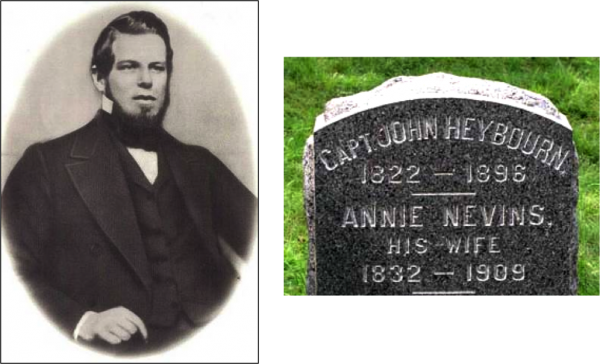
HEYZER, CHARLES H. (1841-1904). Private, 22nd Regiment, New York State National Guard, Company G. He served for three months in 1863. Further details of his service are unknown. His last residence was at 407 Sixth Avenue in Manhattan. His death was caused by apoplexy. Section 2, lot 5499, grave 817.
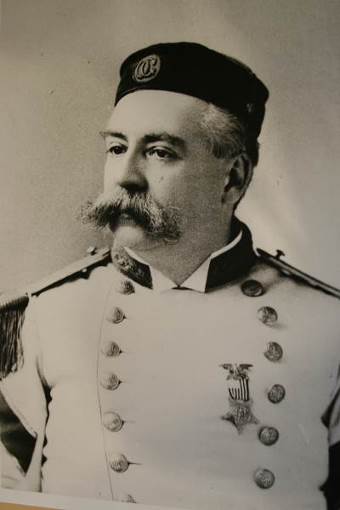
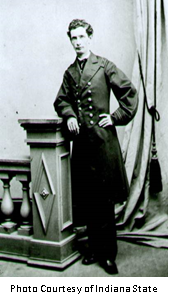
HIBBEN, HENRY BASCOM (1826-1890). Chaplain, 11th Indiana Infantry; United States Navy. Born In Uniontown, Pennsylvania, he was a student at Jefferson College (now Lafayette College) when he decided to change his career path from lawyer to preacher. He transferred to Transylvania College in Lexington, Kentucky, from which he graduated in 1848. His descendant, George Hibben, who wrote about his family’s genealogy in A Social History of the Pioneer Hibben Family 1730 to the Early 1900s, noted that he became a teacher at a female seminary in Indiana in about 1850, then took on a professorship in ancient languages and English literature at what is now DePauw University, subsequently moving to Indiana State University at Bloomington.
A resident of Bloomington when the Civil War broke out, Hibben was commissioned into the 11th Indiana Infantry’s Field and Staff as a chaplain on August 31, 1861. In George Hibben’s article, Minister, Educator, and Historian in the Indiana Historical Society’s publication Connections–The Hoosier Genealogist (Spring/Summer 2008), Bascom Hibben’s letter to his sister dated August 31, 1861, described leaving his family, “I have accepted an appt. as Chaplain to Col. Wallace’s 11th Zouave Regiment and will start for Washington City to join McClellan’s army on next Wednesday or Thursday. Harriet will remain at Bloomington-I will write you as soon as we get to our place of destination. I have no ink and have to write this with pencil-Good bye my dear Sister-Pray for me and mine-” He was present at the capture of Forts Henry and Donelson in Tennessee, the siege of Corinth, Mississippi, and the Red River expedition. After the engagement at Fort Donelson, Colonel George F. McGinnis commended Hibben for “his valuable assistance to the surgeon Thompson which was cheerfully rendered until all of our wounded were cared for and made as comfortable as the circumstances would admit….” Hibben wrote letters to the Indianapolis Herald describing the battles in descriptive language. Hibben’s descendant included these lines of poetry from his battle report of Forts Henry and Donelson:
“For the night clouds had lower’d,
And the sentinel stars set their watch in the sky,
And thousands had sunk to the ground overpowered,
The weary to sleep, and the wounded to die.”
Hibben was present at the Battle of Shiloh, April 6-7, 1862. Years later, he wrote to Confederate General P. G. T. Beauregard and questioned General Lew Wallace’s strategy at the outbreak of that battle. General Wallace, at the order of General Rawlins of Ulysses S. Grant’s staff, returned to Crump’s Landing for fear that the troops would come upon the enemy’s rear and might have been surrounded and captured. The Indianapolis Journal published Beauregard’s letter to Hibben dated May 18, 1881:
Your favor of the 13th inst. has been received, etc. General Lew Wallace’s appearance on our left and rear at Shiloh, after we had got near the river, would have compelled me to retire from the field, for we had then no reserves in a proper condition to meet successfully a flank attack by some 8,000 to 10,000 fresh troops. The fear of such a movement on his part was one of the principal reasons which cause me to issue the order shortly before sundown for the reformation of the different commands in rear of the advanced position we were then occupying, so as to be ready to attack or be attacked early the next morning.
Hibben, in hindsight, told the newspaper that he thought it never entered the minds of any of the Union generals to attack the enemy in the rear. Further, Hibben went on to question whether General Buell was responsible for preventing the annihilation of Union troops when he came to Grant’s aid in the counteroffensive on the second day of the battle. Hibben said:
I would not detract anything from the laurels of Gen. Buell, much less would I try to disparage his competency and courage, but I have to say, finally, that the wonder to us was not that Gen. Buell took an active, honorable part in the second day’s fight at Shiloh, but rather that we had to fight the first day’s battle without his presence or aid.
After resigning his commission on May 12, 1864, he subsequently joined the United States Navy Yard as a chaplain on July 2, 1864. He served as a chaplain, with the rank of lieutenant commander, in numerous Navy hospitals, and, among other posts was an instructor at the Naval Academy at Annapolis, Maryland, the school-ship on board the USS Constitution, and was subsequently at the Brooklyn Navy Yard. From there, he continued his service aboard the USRS Vermont and the USRS Colorado. While on the Vermont on February 1, 1873, he developed pleurisy while preaching on an open deck in a cold wind and was admitted to the ship’s hospital and discharged on March 4 to the Brooklyn Navy Yard. He attained the rank of commander on January 1, 1874, and captain on January 1, 1882. Hibben spent four years at the naval asylum at Philadelphia from 1880-1884 before returning to the Vermont and the Colorado. Assigned to the Washington Navy Yard during the last three years of his life, he wrote a comprehensive history of that facility that was ultimately forwarded to the Secretary of the Navy and printed. Hibben said of his history:
First. It has been prepared entirely from the official manuscripts, books and documents of the Navy department, and is therefore reliable history.
Second. It contains interesting historical matter connected with the War of 1812, and also with our late civil war, never before published, as well as important corrections of verdicts pronounced by standard histories, on a partial knowledge of the facts in the case, condemning a former Secretary of the Navy and Captain Tingey, a distinguished naval officer.
I have endeavored to avoid dry detail so far as possible, and I believe the history will prove to be of general interest as well as a useful addition to our naval literature….
His papers, which are archived at DePauw University in Indiana, include his recollections of the Navy during the Civil War. Hibben recalled:
…A great and prosperous nation’s proudest inheritance is the record of the glorious and patriotic deeds of her sons. The nation may indeed die; but the noble, patriotic action of her sons will live on….But all history teaches, that if we let this spirit of true patriotic appreciation and acknowledgment of patriotic deeds die out, or be crushed out, of the hearts of the people, the nation, however rich and powerful, will degenerate and perish….God of our fathers, give to us all-East, West, North, South-the spirit of true, lofty and unfading patriotism, and then may we fearlessly and confidently hope that the eagle upon our banner, that has hitherto guided us to victory against foreign and domestic foes, shall never behold one dark spot in the starry firmament that shines around him, but bear them all onward forever, the ever-glowing emblem of that Union which the Navy will be ever ready to defend, and which none but ourselves can ever destroy!…
On June 13, 1890, he was hospitalized with chronic myocarditis originating from his professional duties; an autopsy revealed degeneration of his heart muscle. At the time of his death, he was at the New York Navy Yard and was the oldest service chaplain in the Navy. His last residence was on Cypress Avenue in Brooklyn. In 1891, his widow, Harriet Hibben, received a pension of $30 a month from the Navy, certificate 10,064, but her request for an increase, made in 1912 on account of her diminished vision due to cataracts and glaucoma, was denied because there was no provision in the law that allowed for such an increase. Section 173, lot 20683.
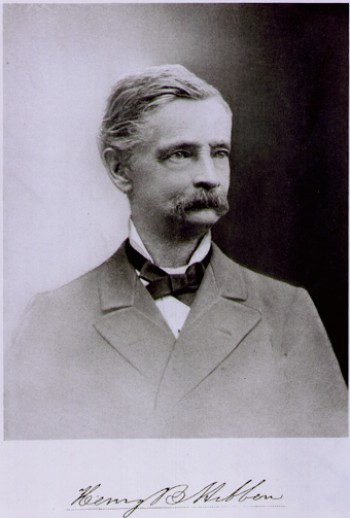
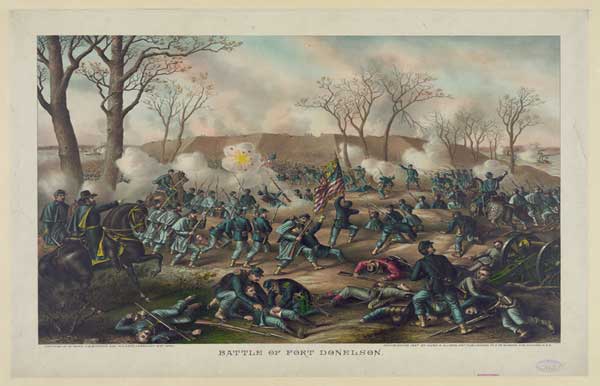
HICKEY, WILLIAM (also enlisted as THOMSON, CHARLES) (1845-1914). Ordinary seaman, United States Navy. Hickey, who was born in Southfield, New York, served in the United States Navy under the alias Charles Thomson (also spelled Thompson on some documents). A resident of Boston, Massachusetts, he enlisted there as a landsman on October 22, 1862, at the Receiving Ship Ohio, serving aboard that vessel until November 10. At the time of enlistment, he was 5′ 11″ tall with blue eyes, auburn hair and a fair complexion. He served as a landsman aboard the USS Colorado until January 24, 1863, and then for a very short time aboard the USS Clara Dolsen until January 31. Subsequently, he was a landsman and an ordinary seaman on the gunboat USS Lafayette until August 3, 1863. During his time on the Lafayette, he was admitted to the ship’s hospital on June 2 with intermittent fever, attributed to “climatic influences,” and returned to duty on July 5. However, the condition returned and he was rehospitalized on August 2. He was discharged on August 6 but was soon re-admitted to the USS Red Rover, a Confederate ship captured and refitted by the U.S. Navy as a hospital ship. He remained hospitalized on the Red Rover until August 14 when he was transferred to the USS Pinkney, another hospital ship. He was hospitalized there until his discharge on October 21, 1863, at Memphis, Tennessee, at the expiration of his enlistment.
As per his pension application, Hickey sailed with the merchant service after his discharge until 1868. At some point, he joined the New York City Police Department and retired after 23 years of service as a sergeant. He was a member of the Germain Metternick Post #122 of the G.A.R. In 1901, he applied for and received a pension from the Navy citing rheumatism, pleurisy, lumbago, piles and heart disease; it was approved under certificate 32,610; his pension was increased to $12 per month in 1907. At the time of his pension application, he was 5′ 11½” tall, weighed 190 pounds, had gray hair, and listed his occupation as salesman. He also indicated that he had two India ink spots on his body, a blue spot on his right arm and faded “W. H.” initials on his left forearm. The examining surgeon noted that rheumatism and sciatica in the left leg were the primary reasons for Hickey’s inability to perform manual labor. Hickey officially changed his name on Navy records at the time of his first pension application. His obituary in The New York Times confirms his Civil War service. His last residence was 232 Grove Street in Brooklyn. He succumbed to pneumonia.
In 1915, Ophelia Hickey applied for a widow’s pension; her request was met with letters asking for official marriage and death records as well as the sworn testimonies of two witnesses. George Dietrich, a past commander of his G.A.R. Post, submitted one affidavit to the commissioner of pensions. Although Ophelia Hickey, in her hand-written letter described herself as a 54 year-old who had a bad arm and not a cent to her name, she had been married to her husband for only 13 months before he died; pension laws limited eligibility to marriages occurring before June 27, 1890. She noted that her husband had stomach troubles and that he died shortly after she gave him medicine for pneumonia. She also wrote letters asking for his back pay up until his date of death; after much paperwork, her request for Hickey’s accrued pension was granted. Section 80, lot 10726.